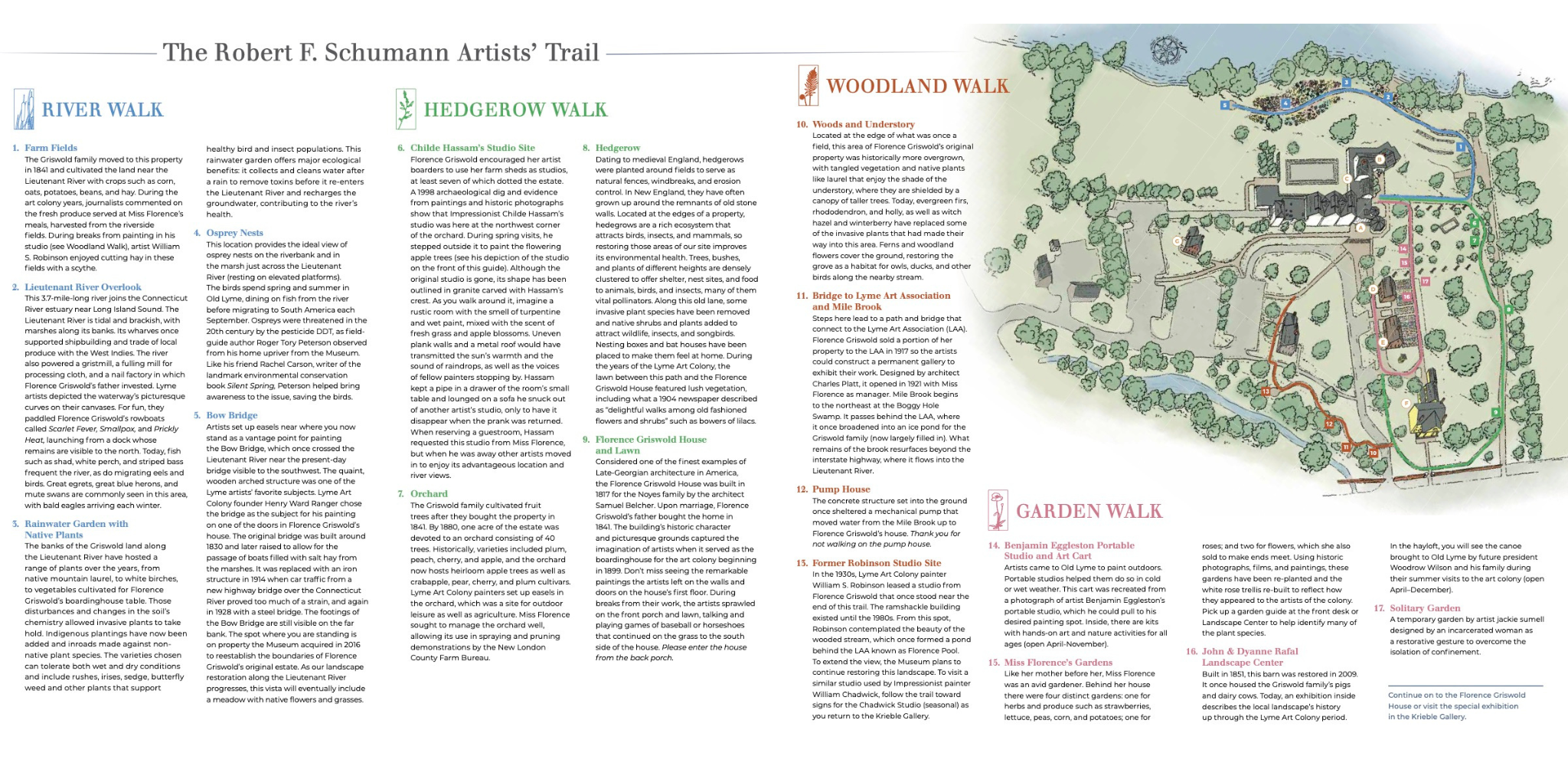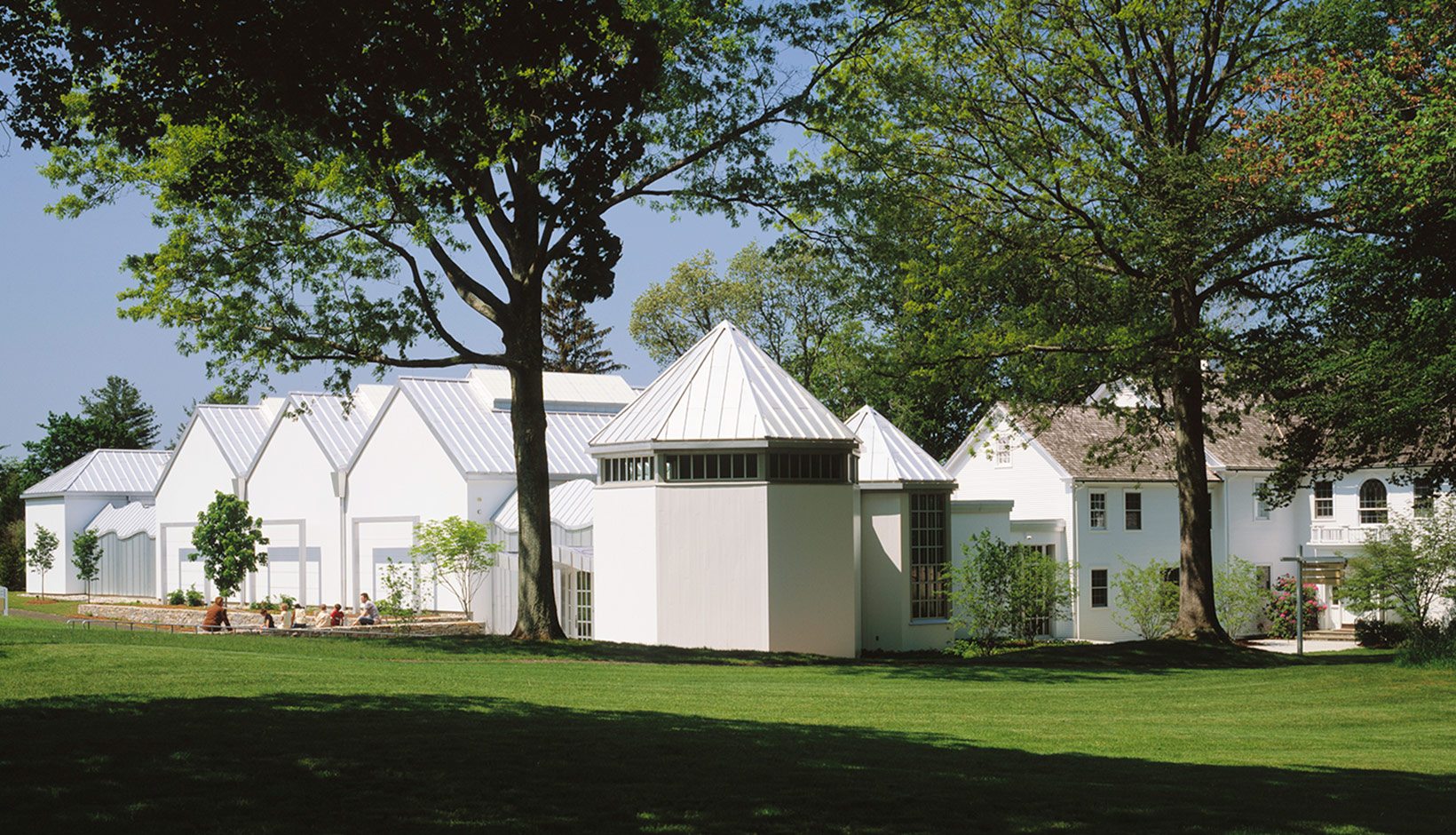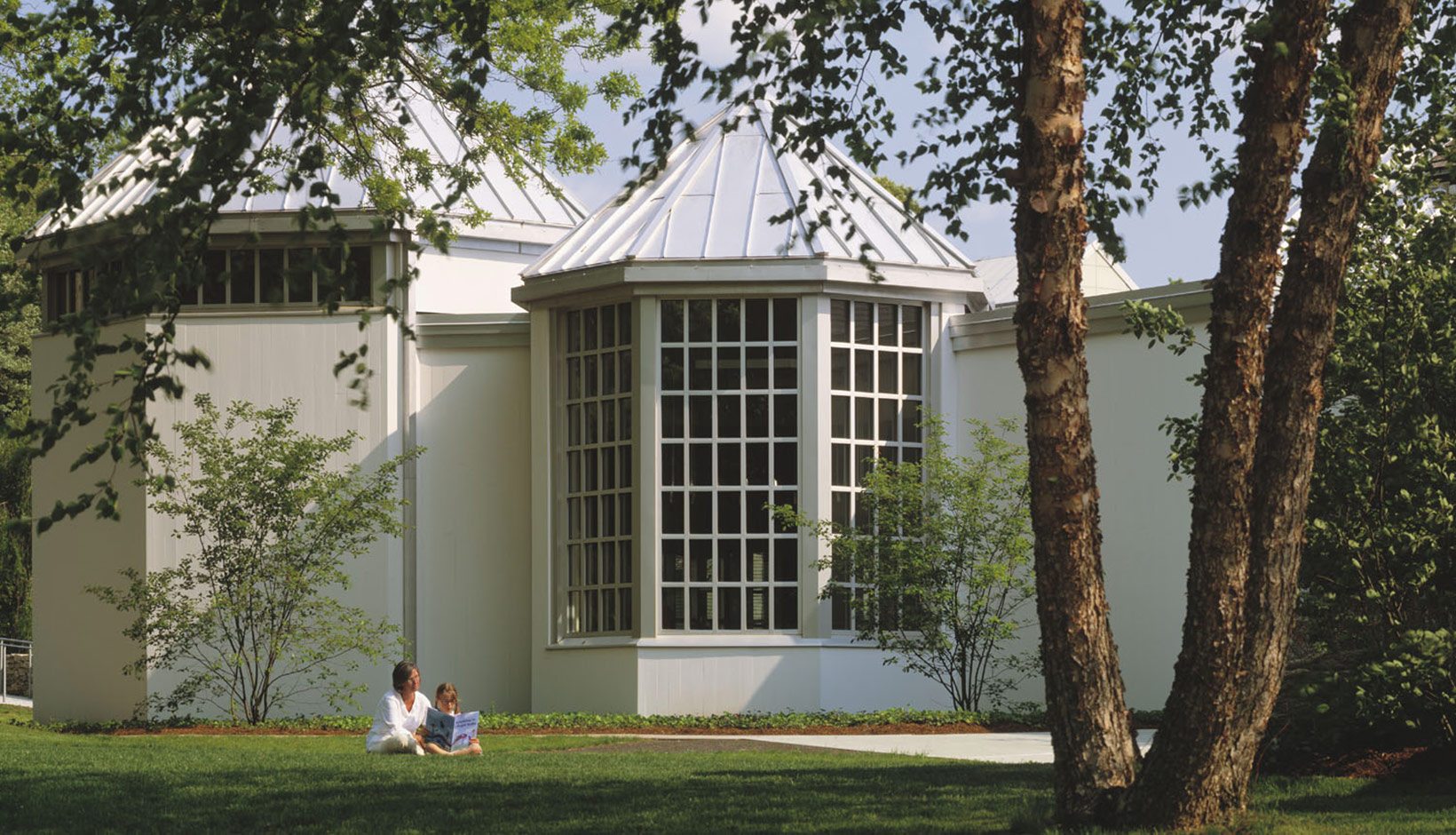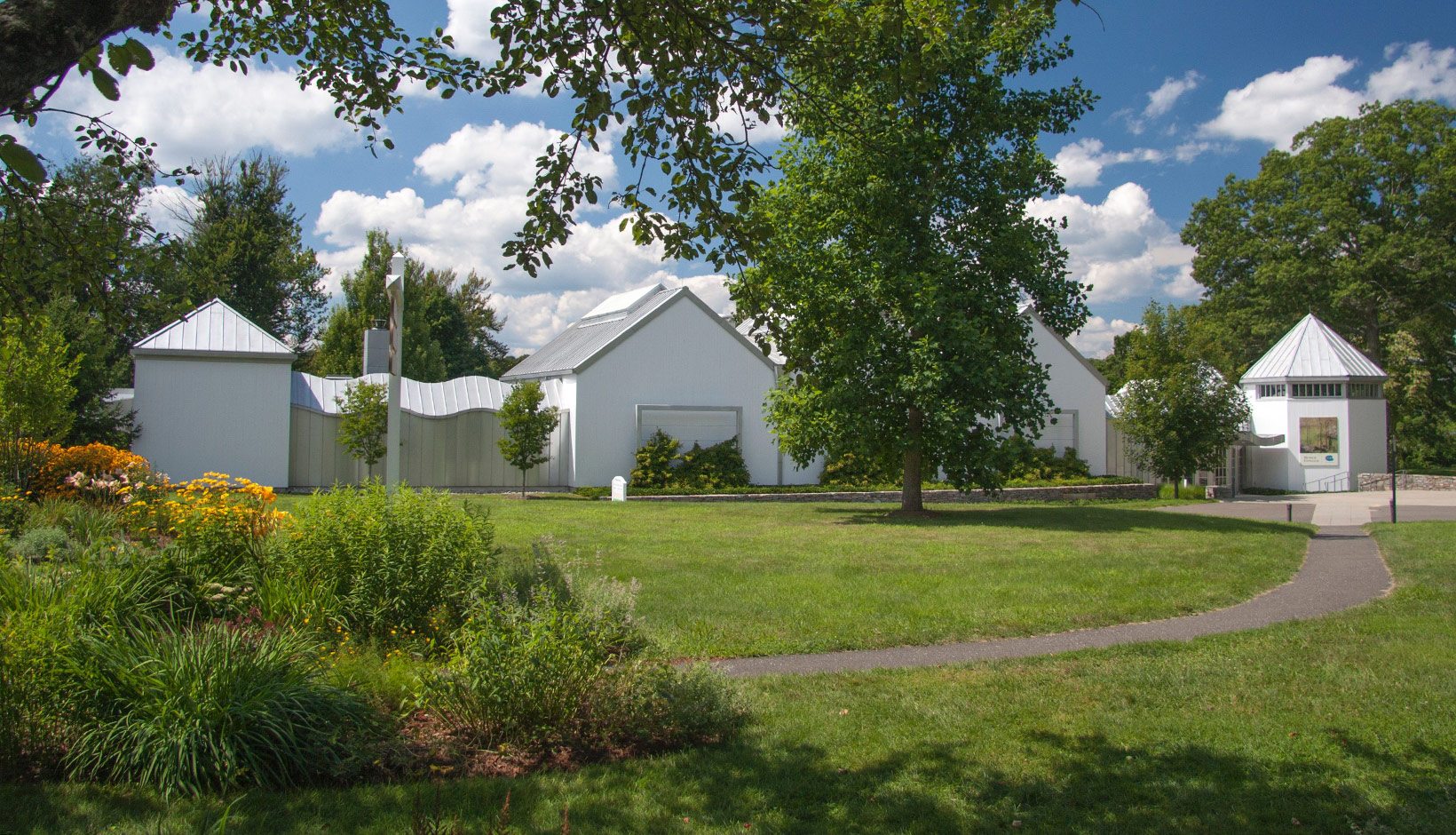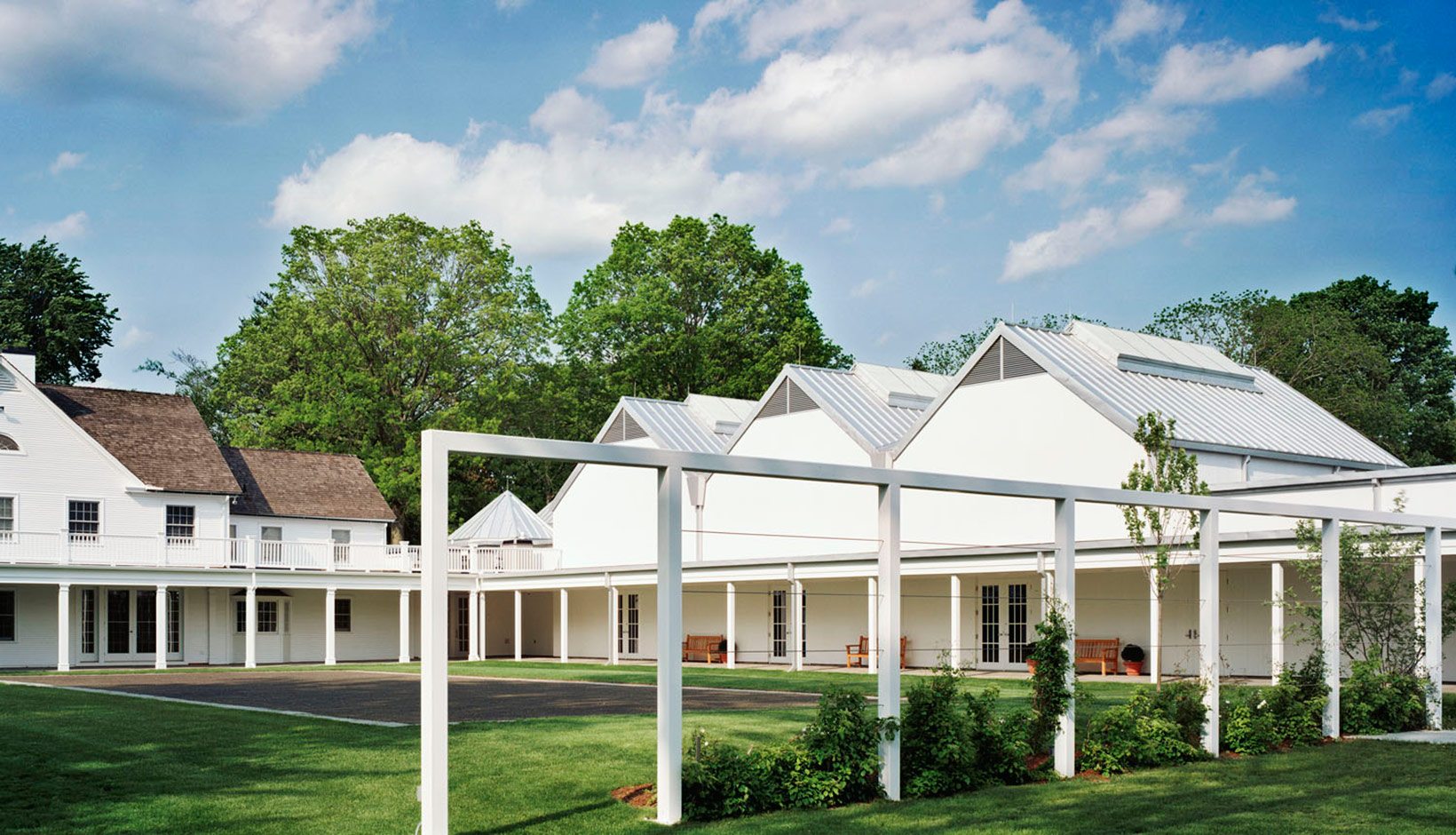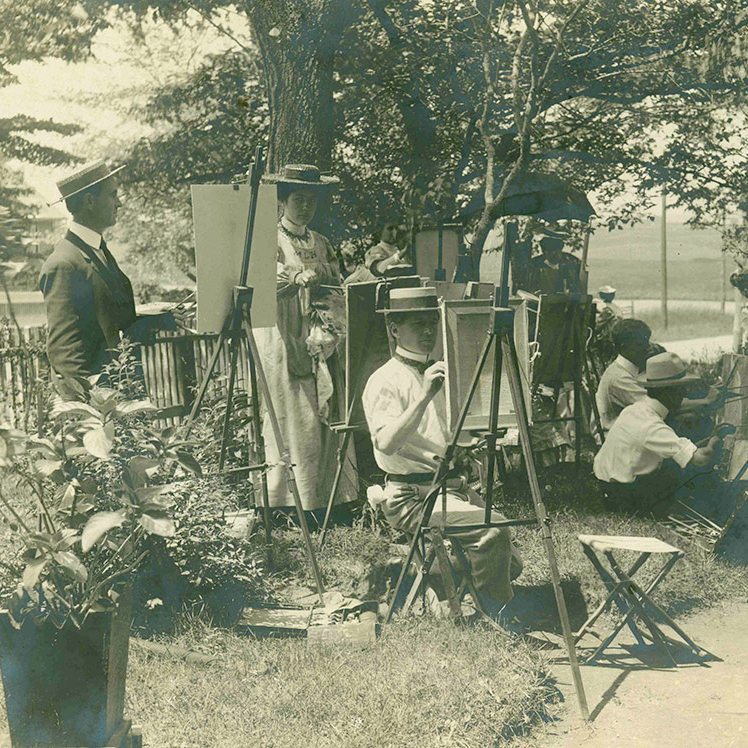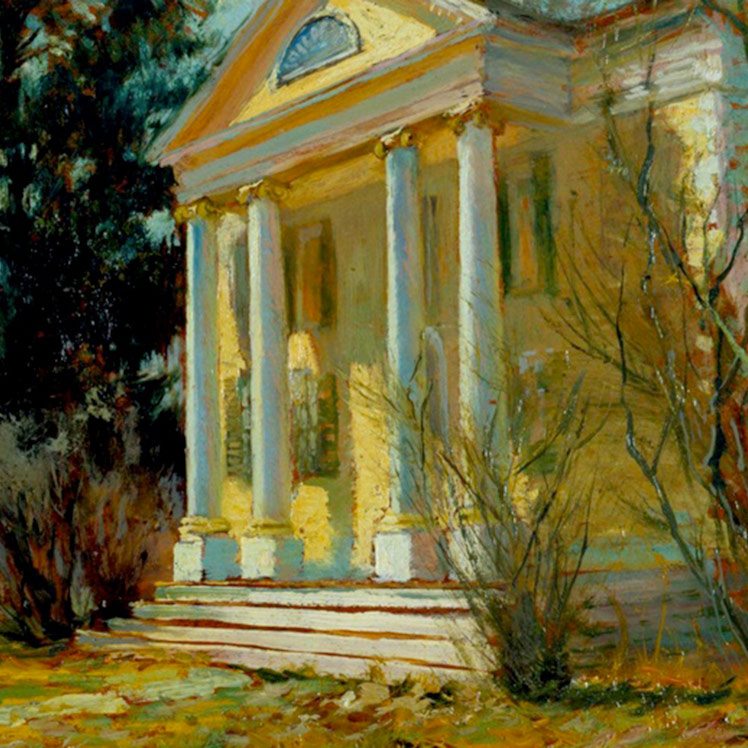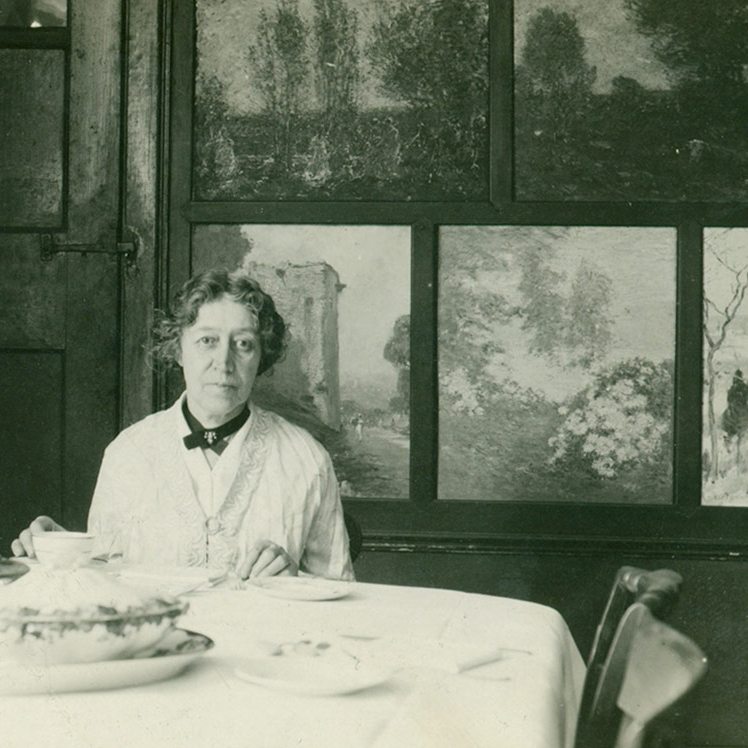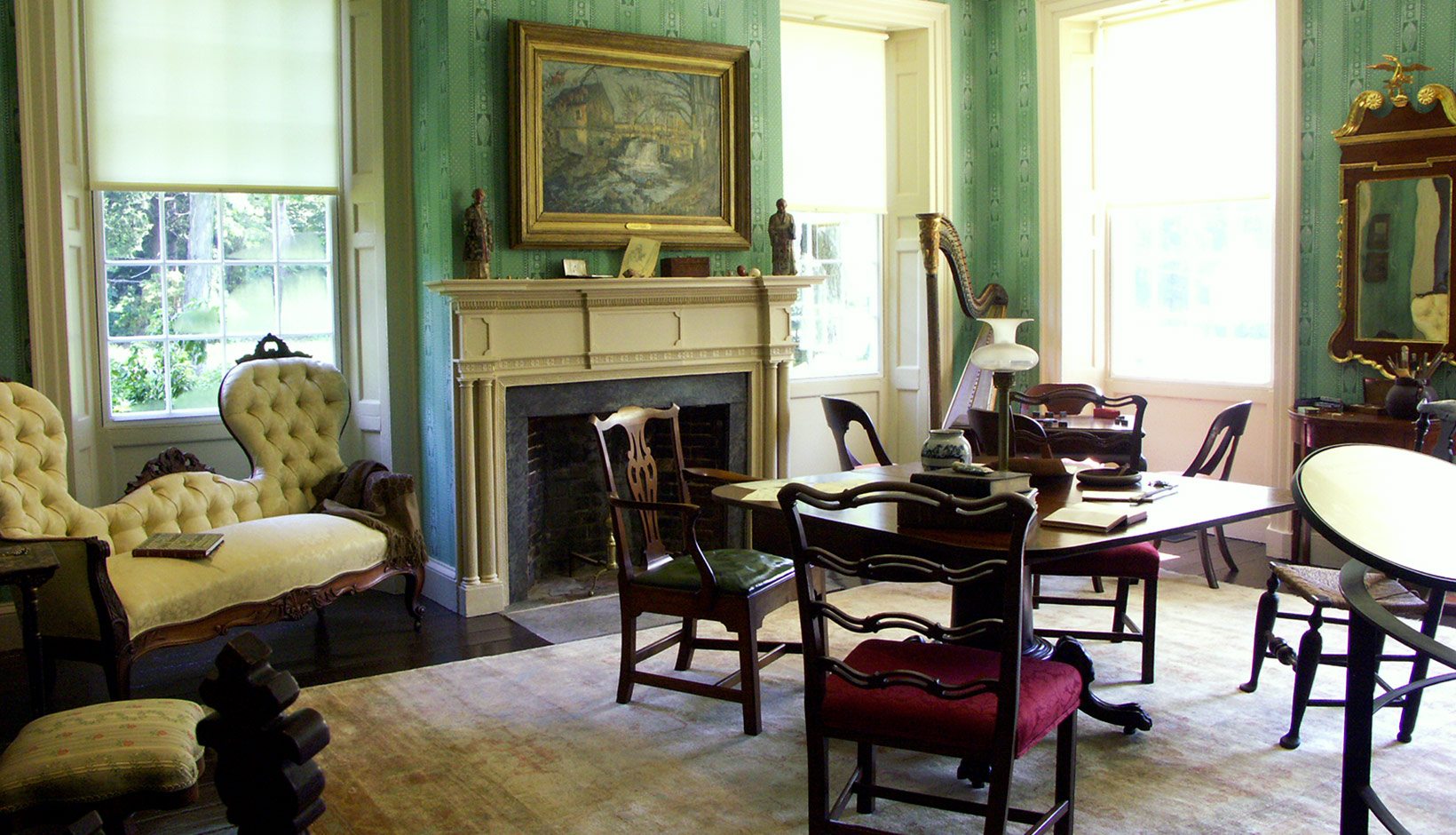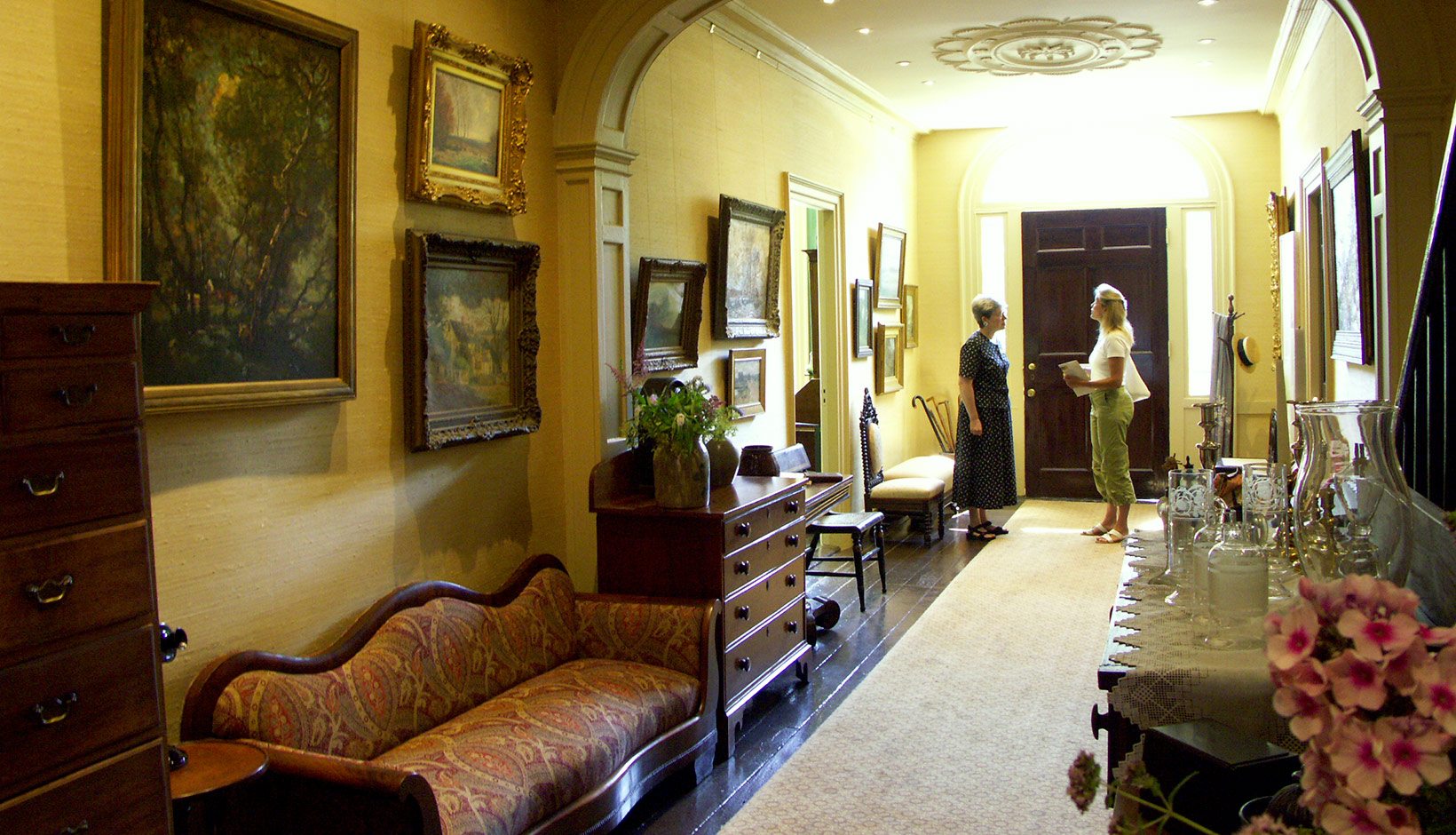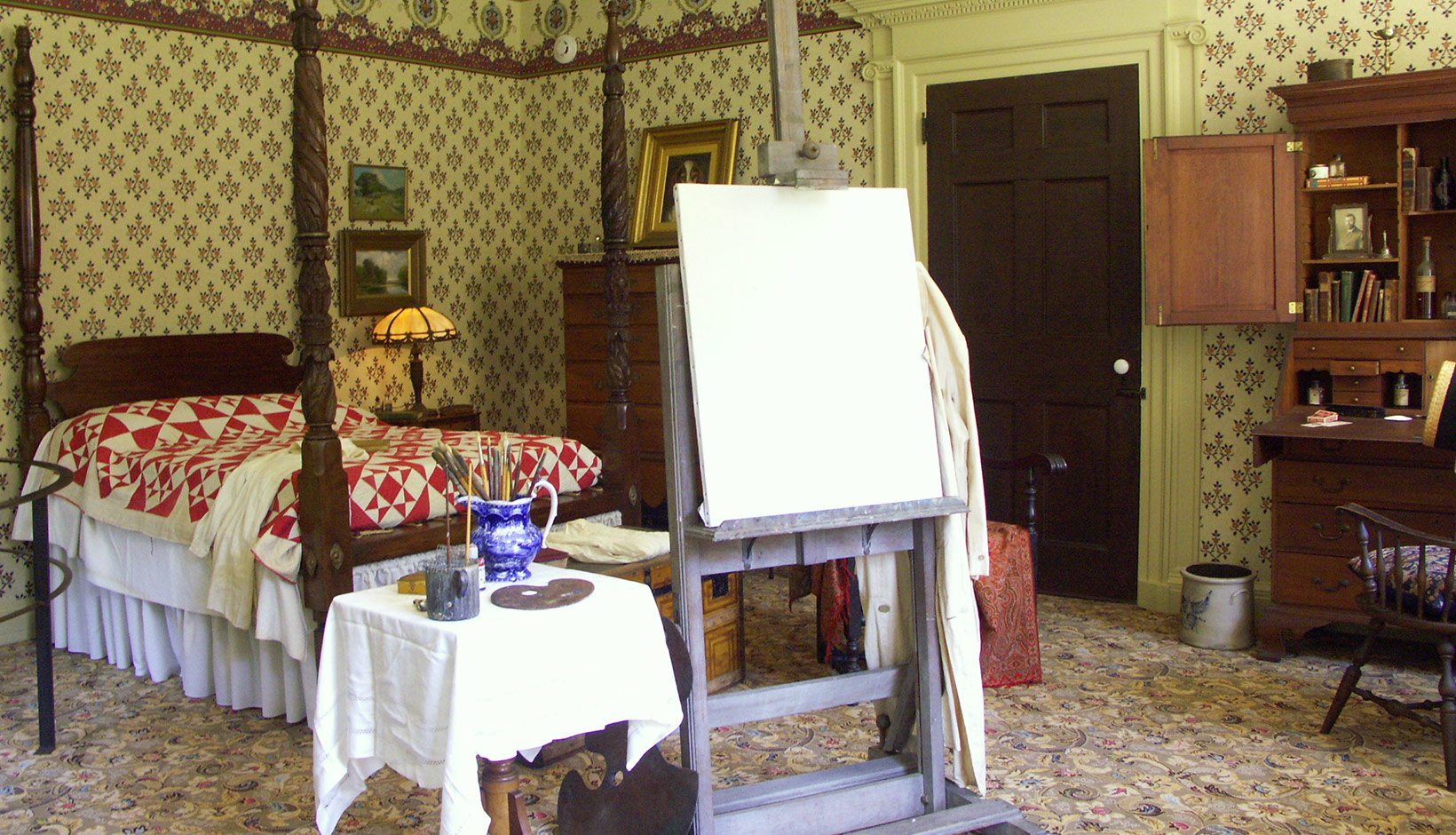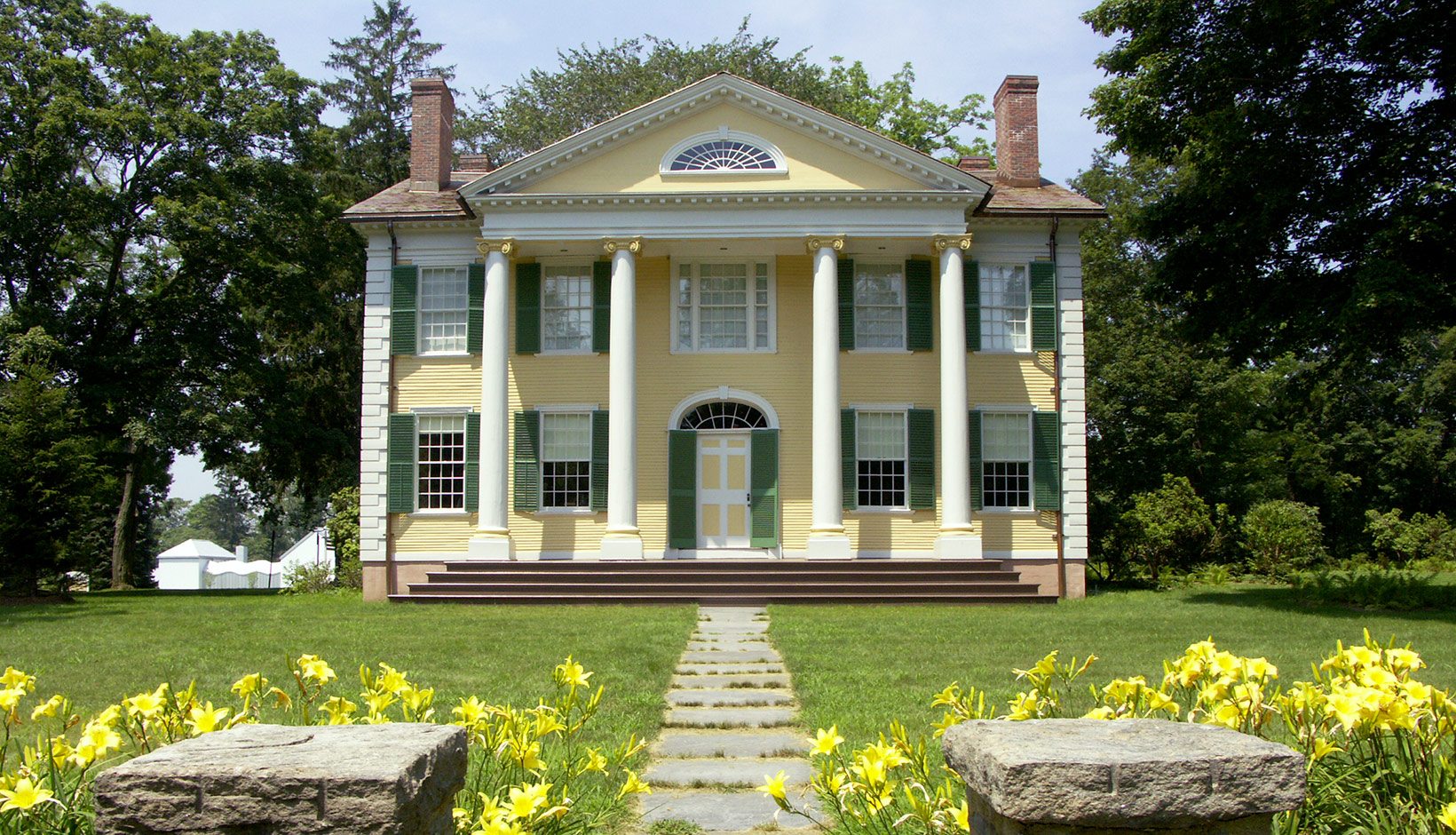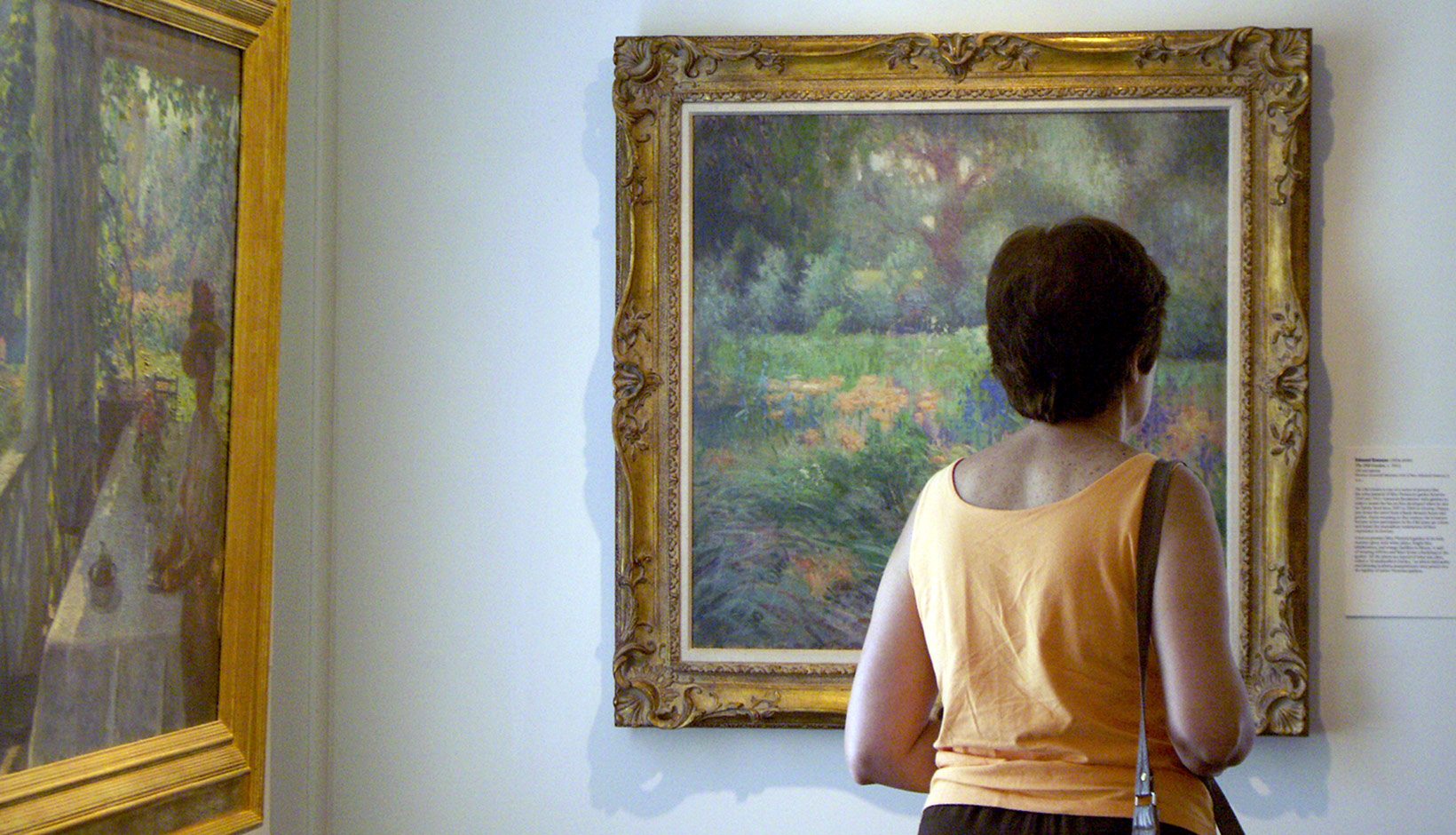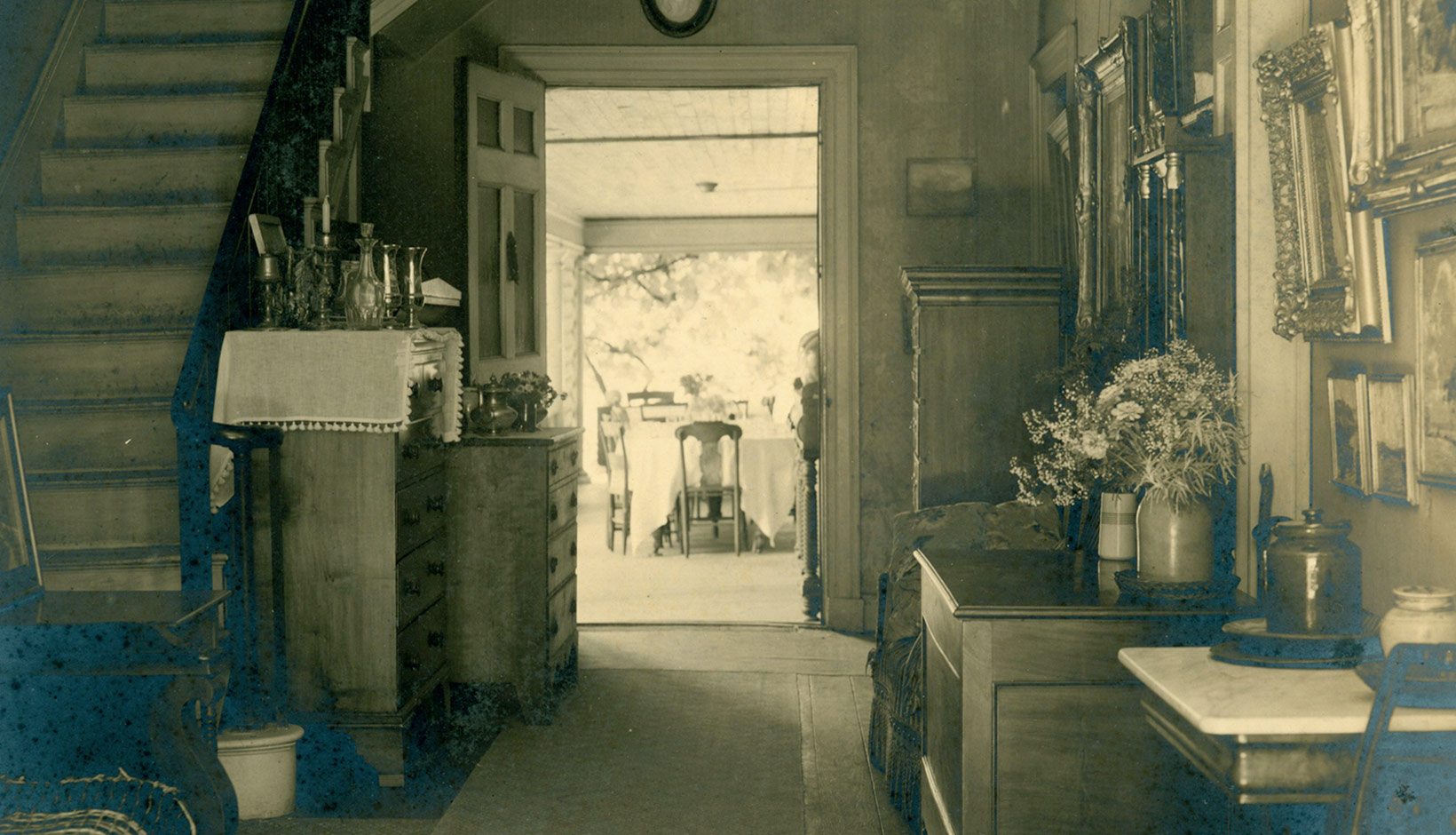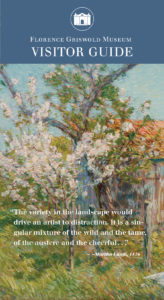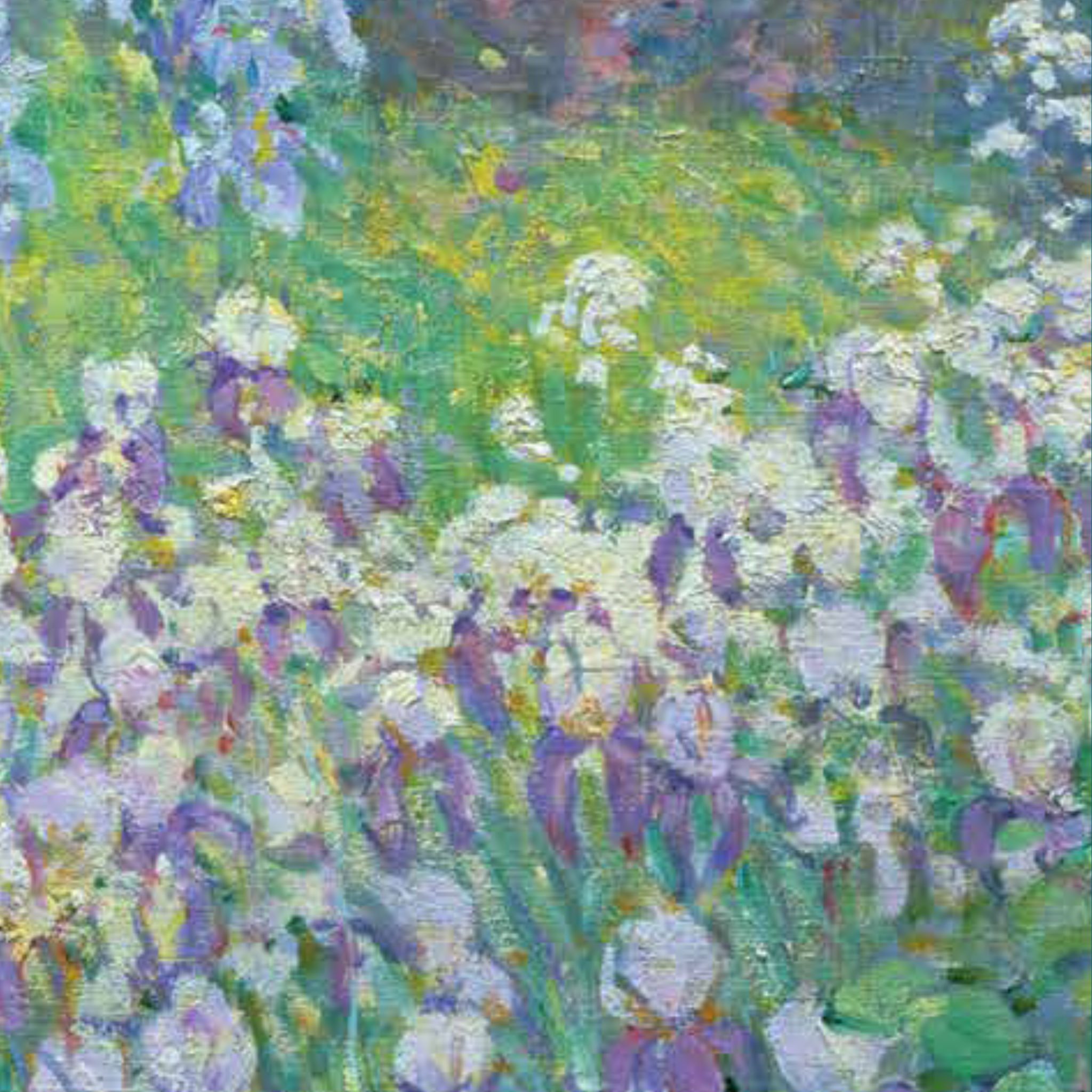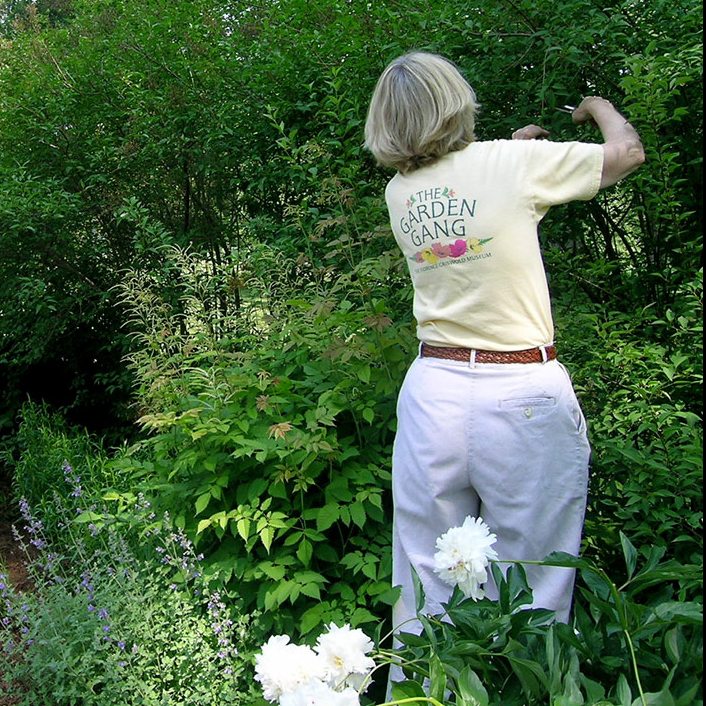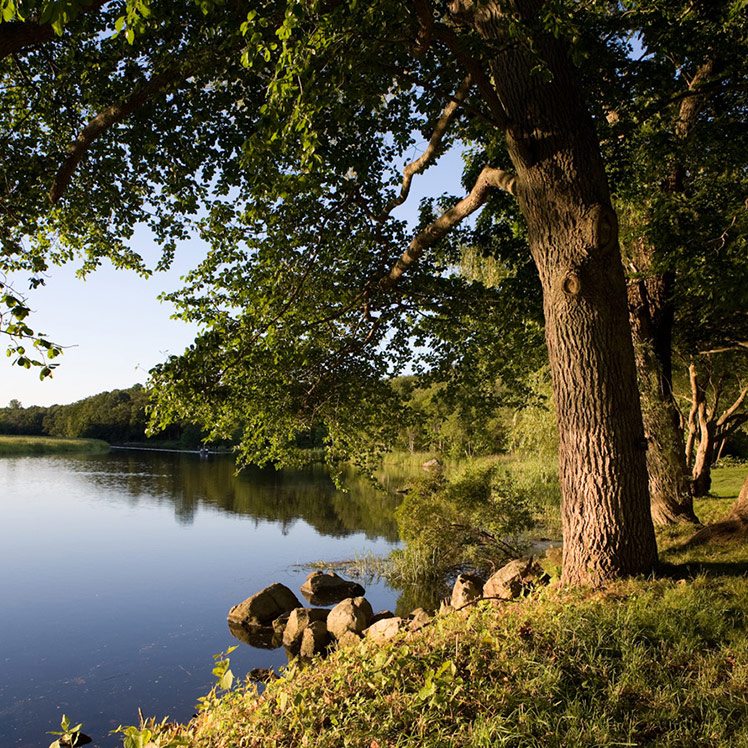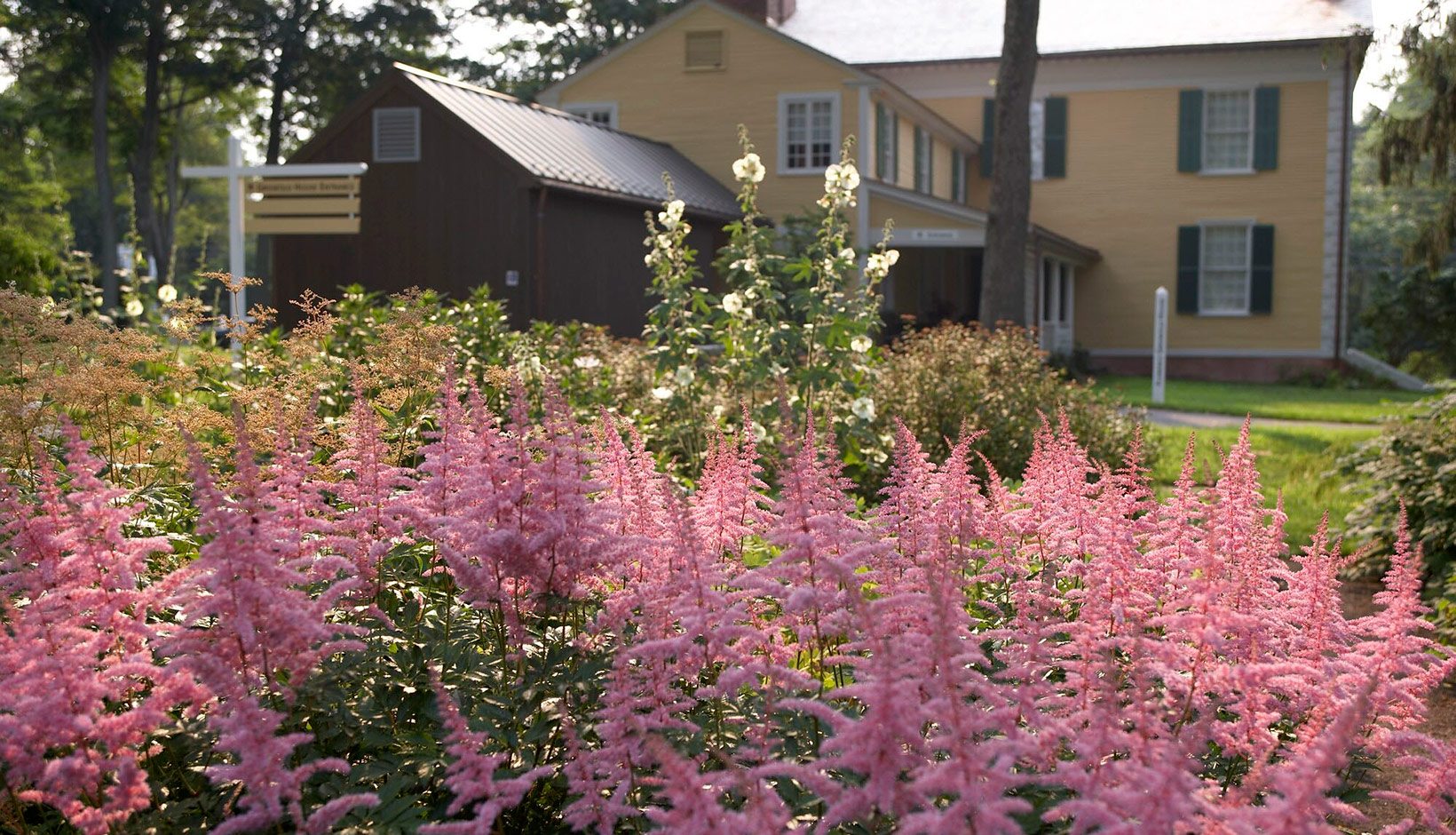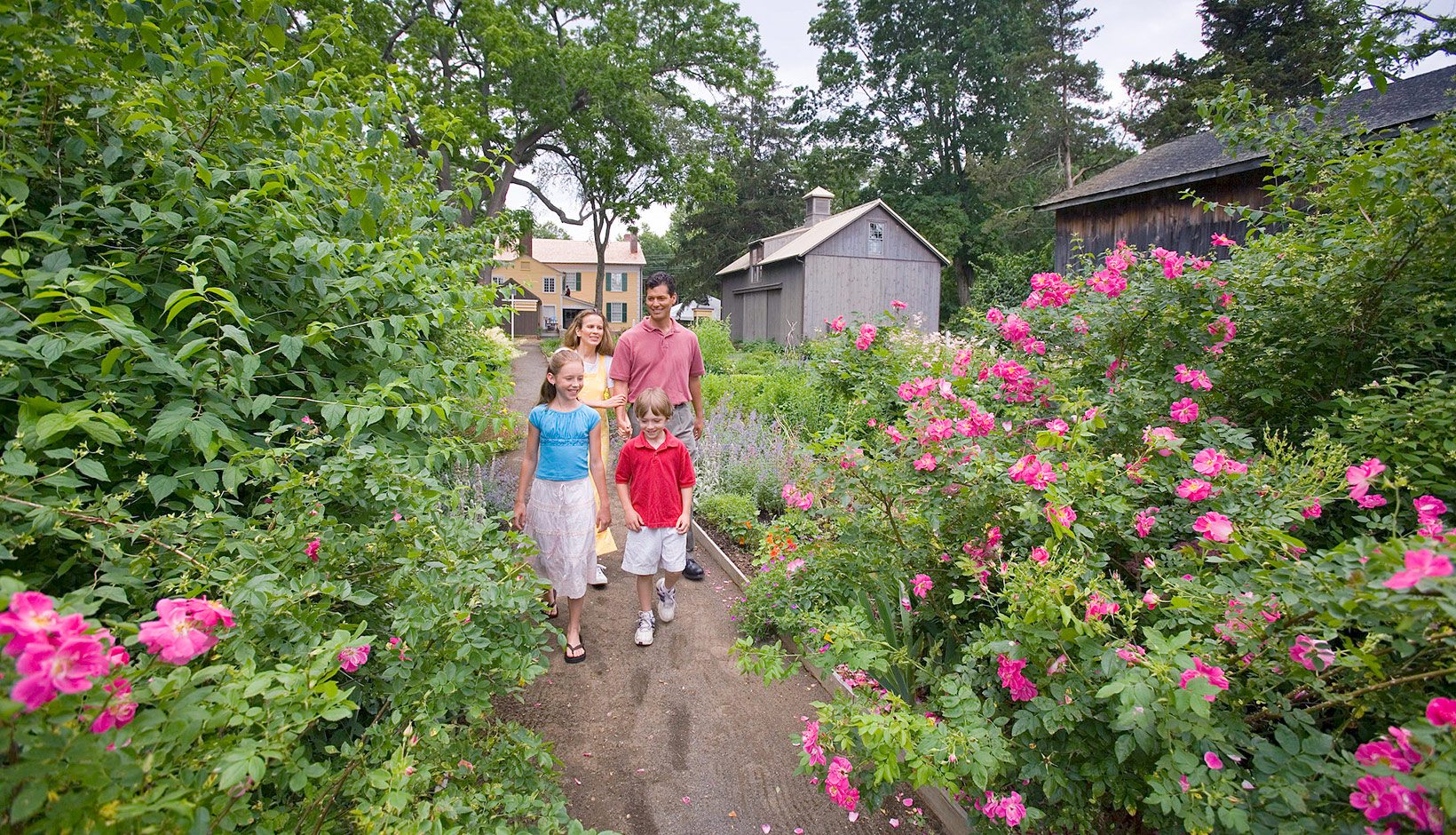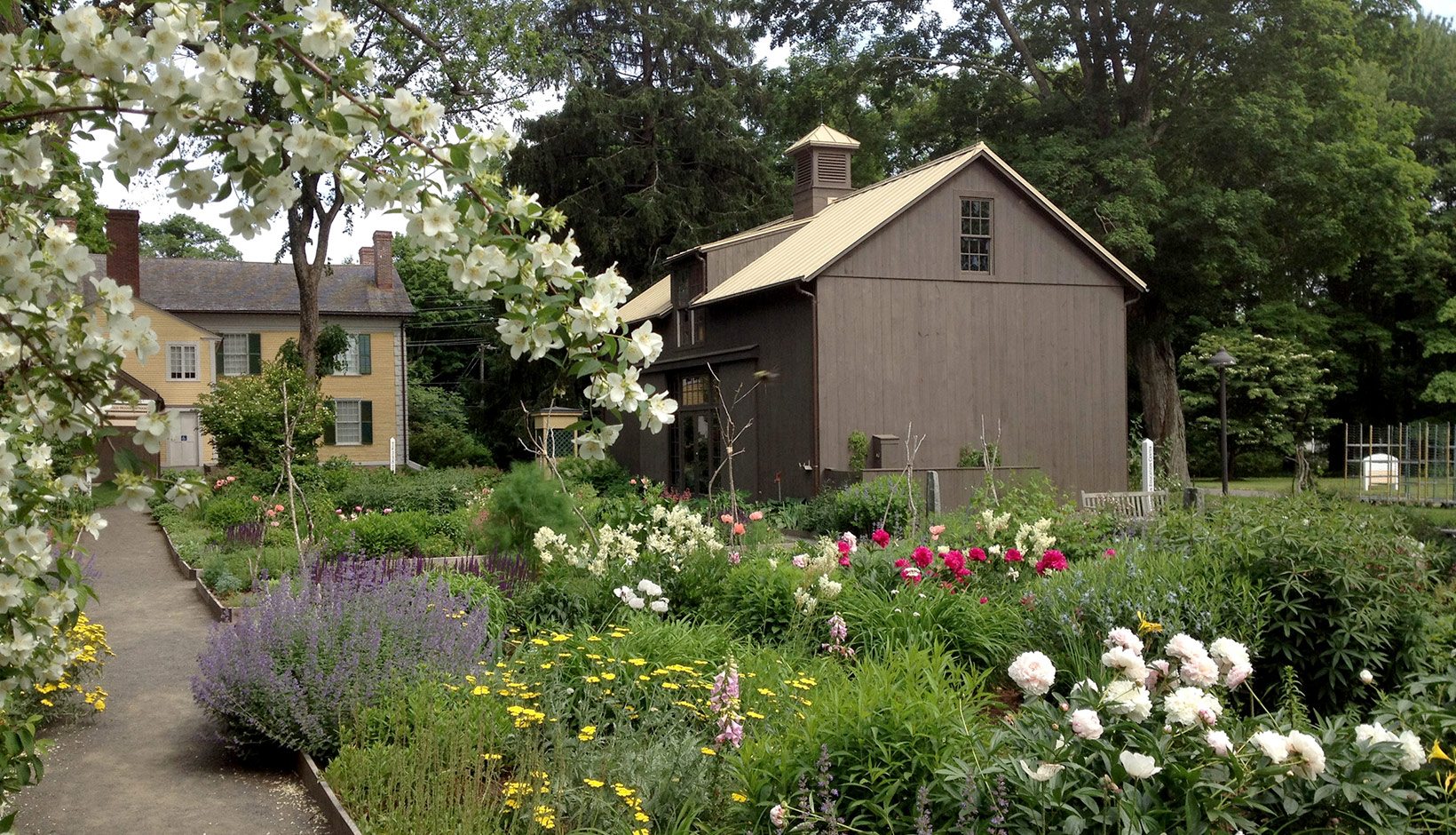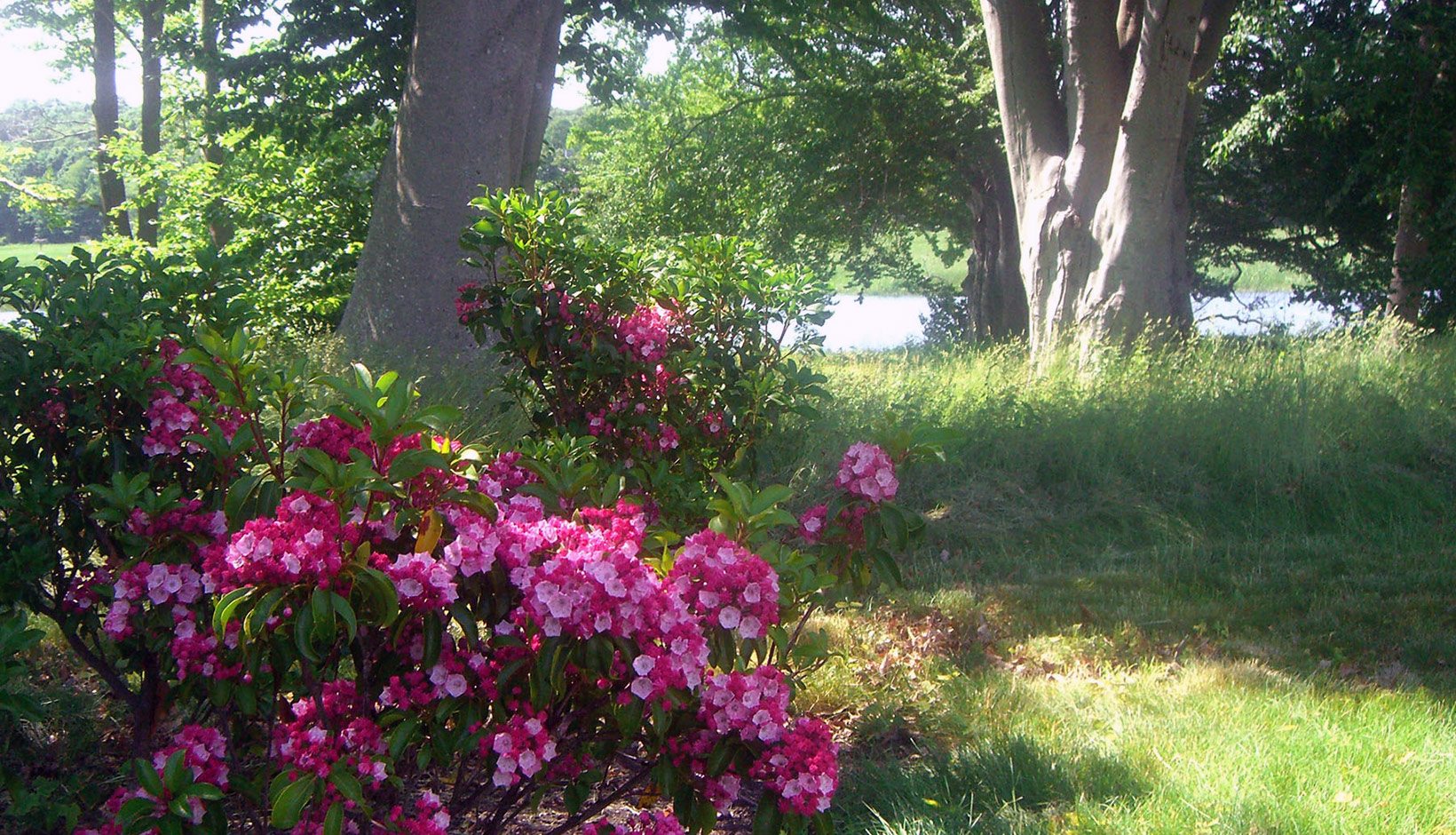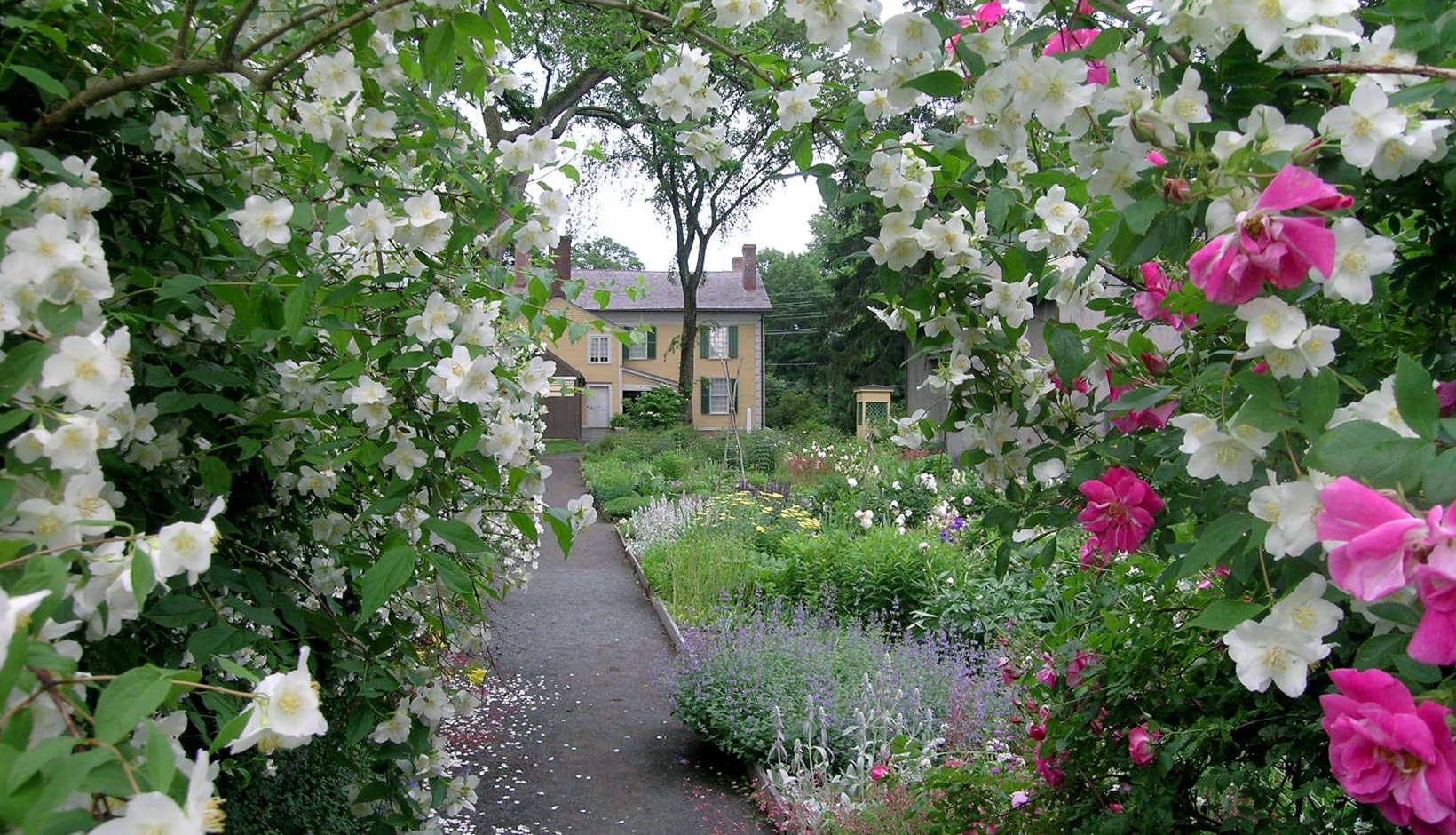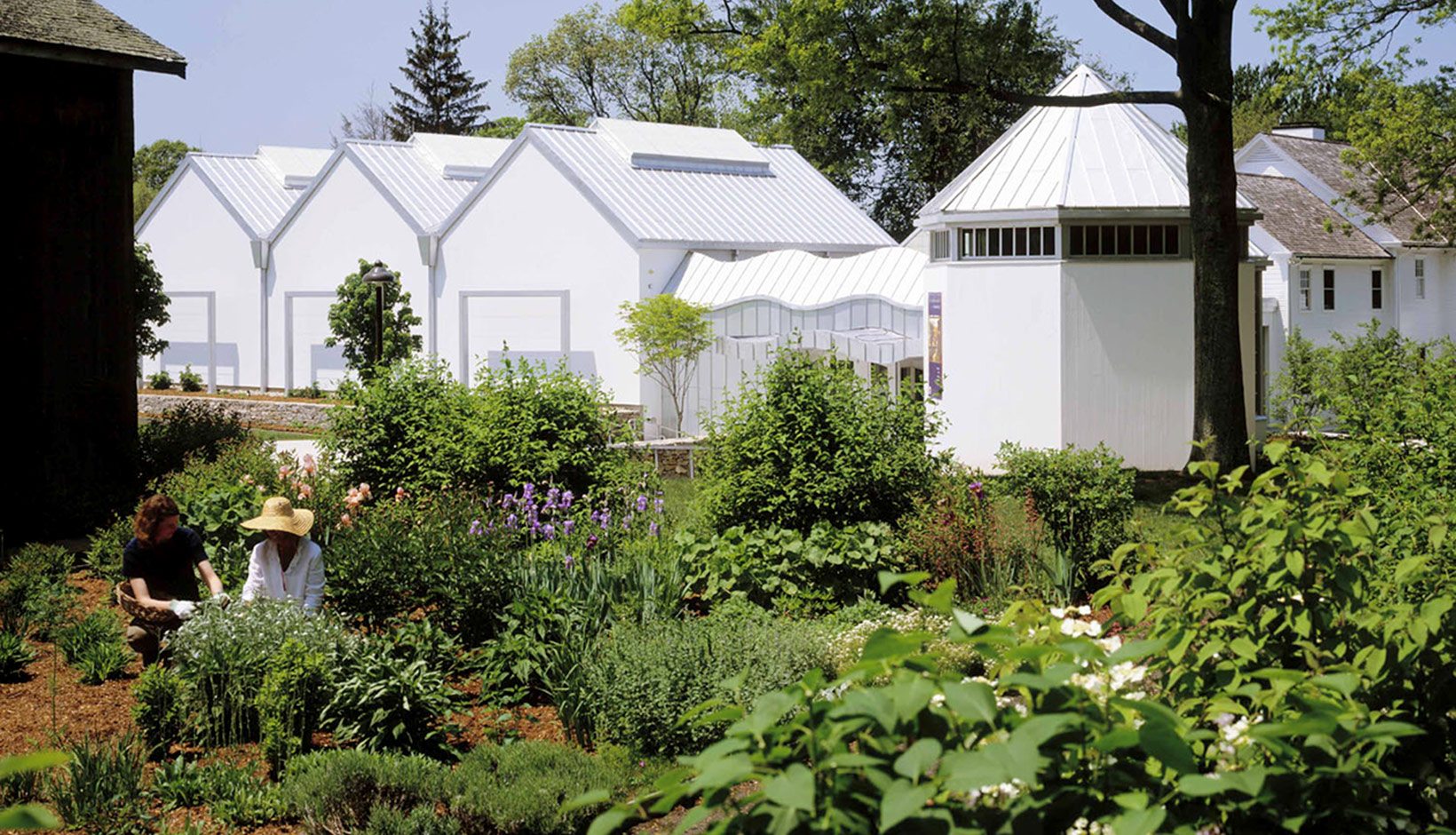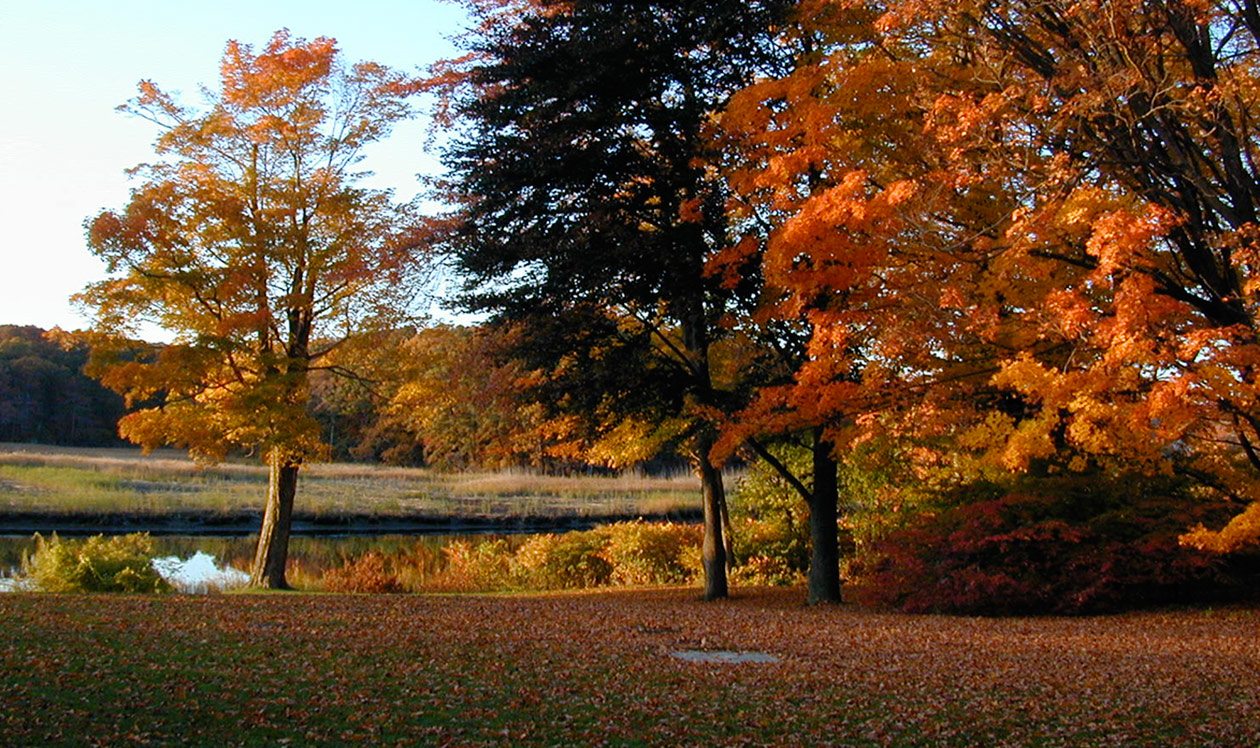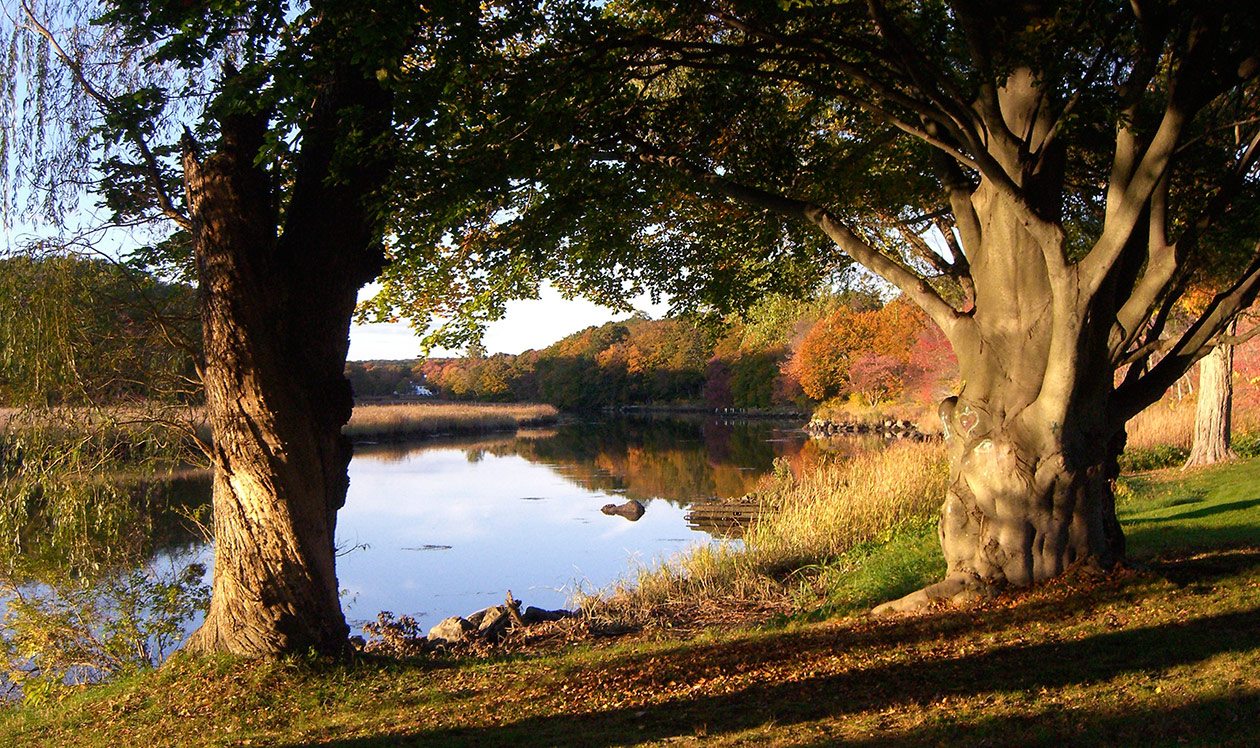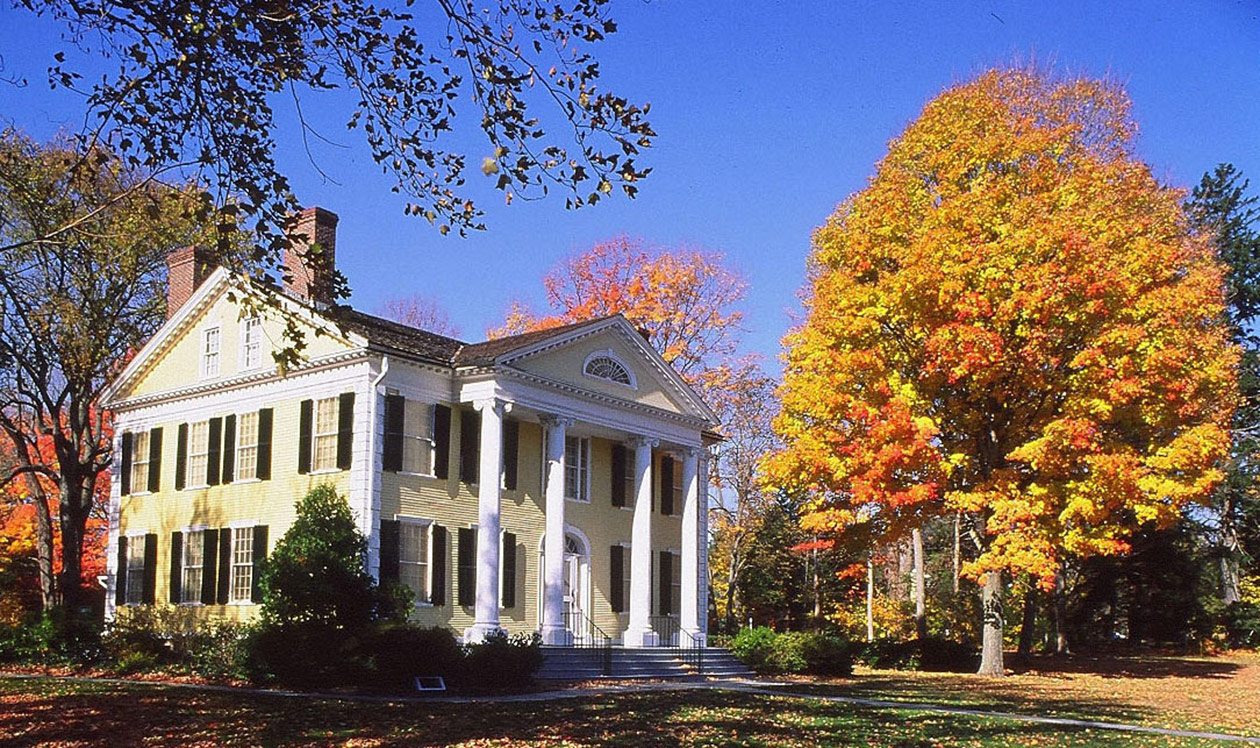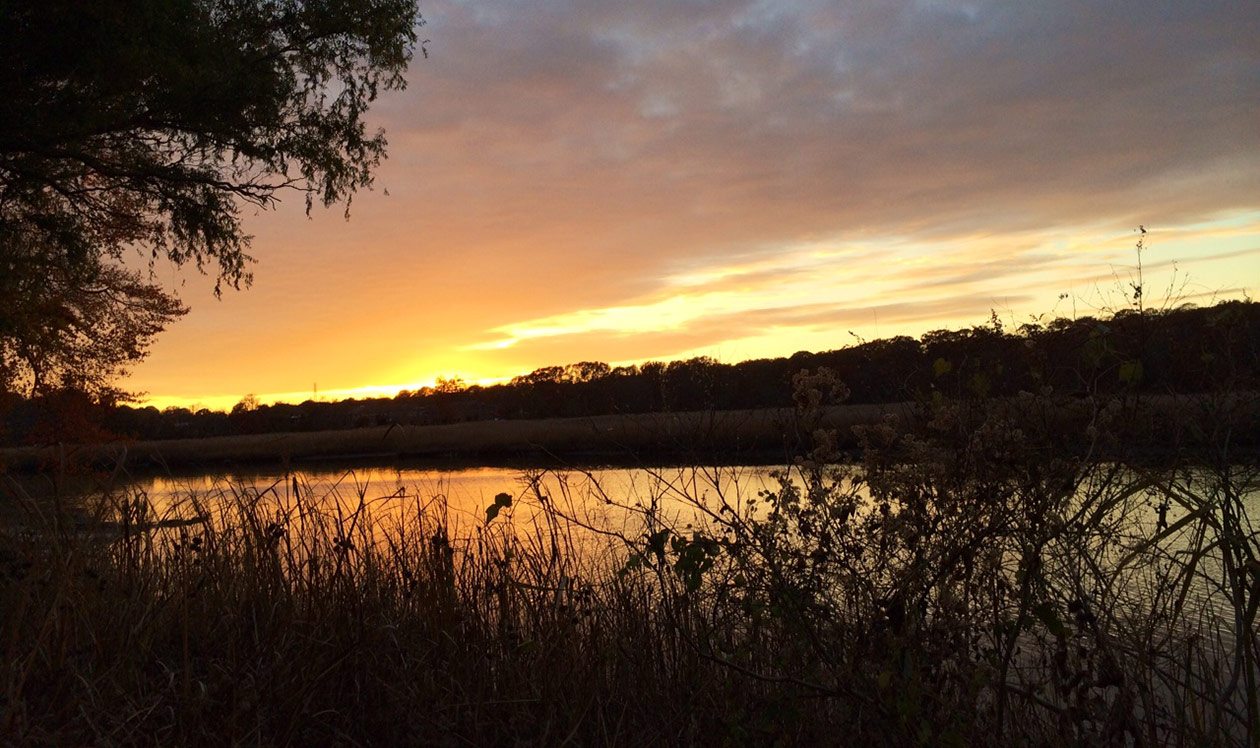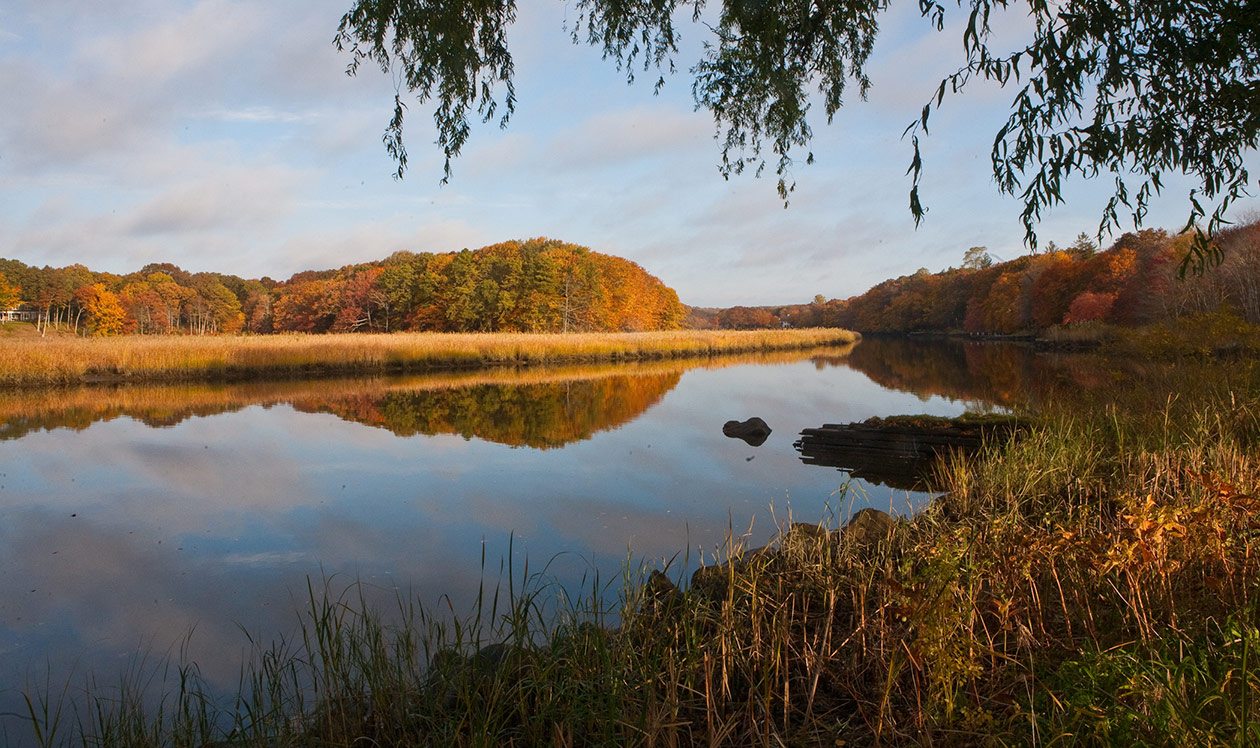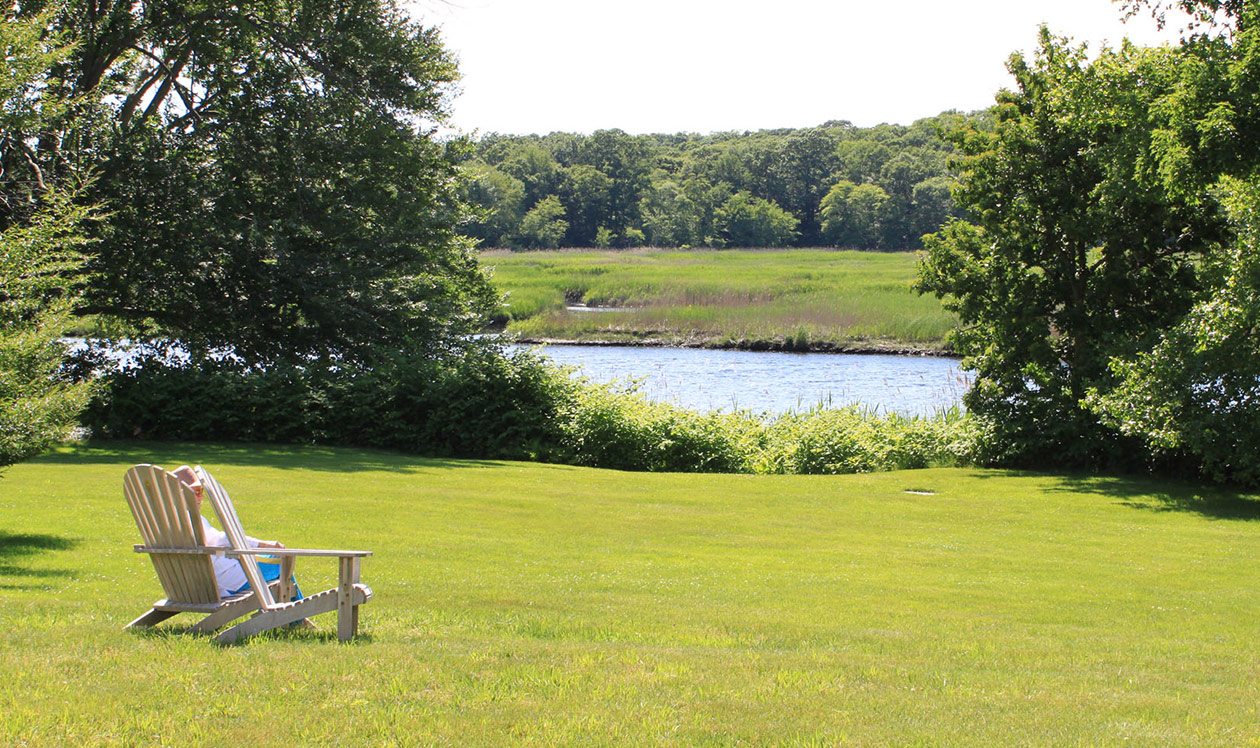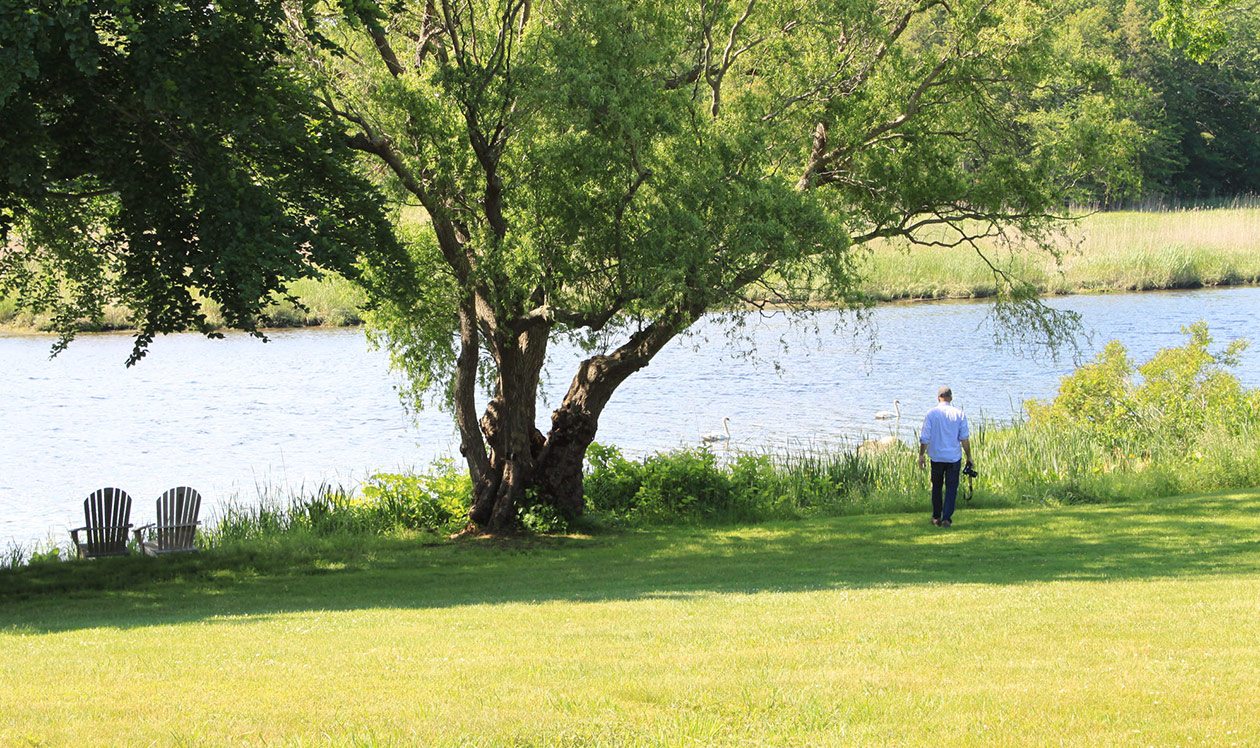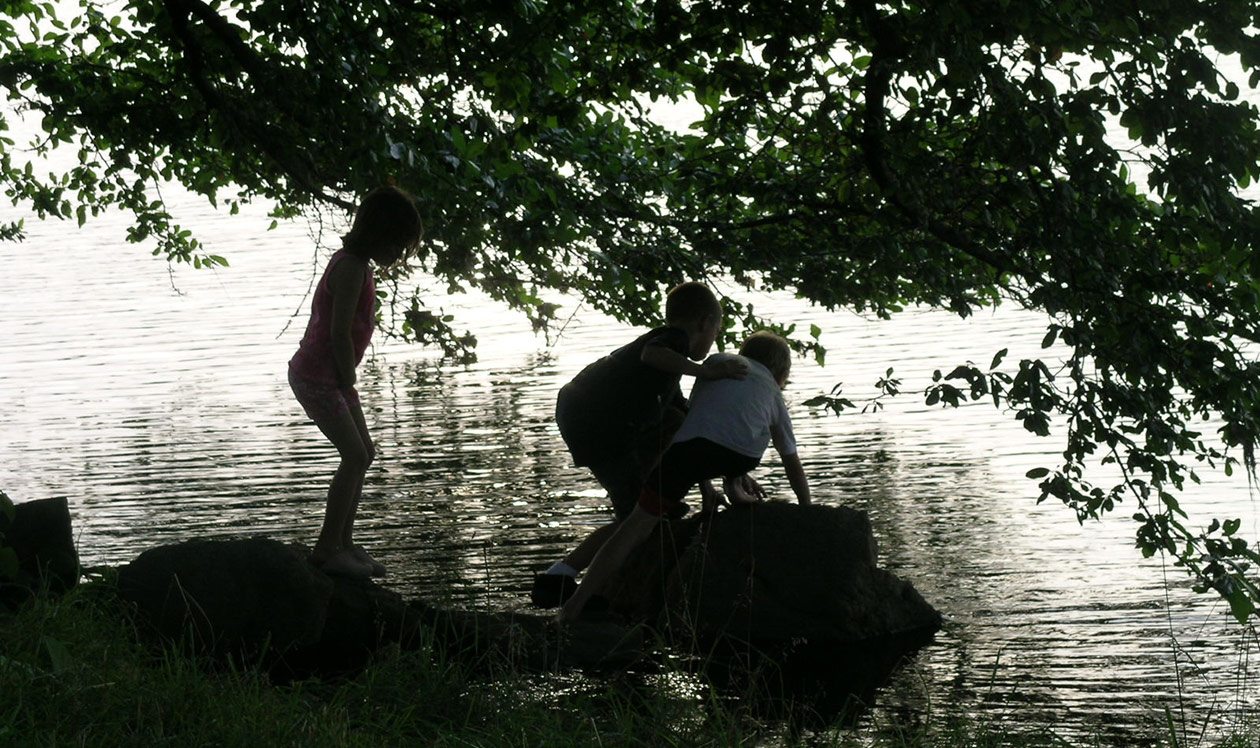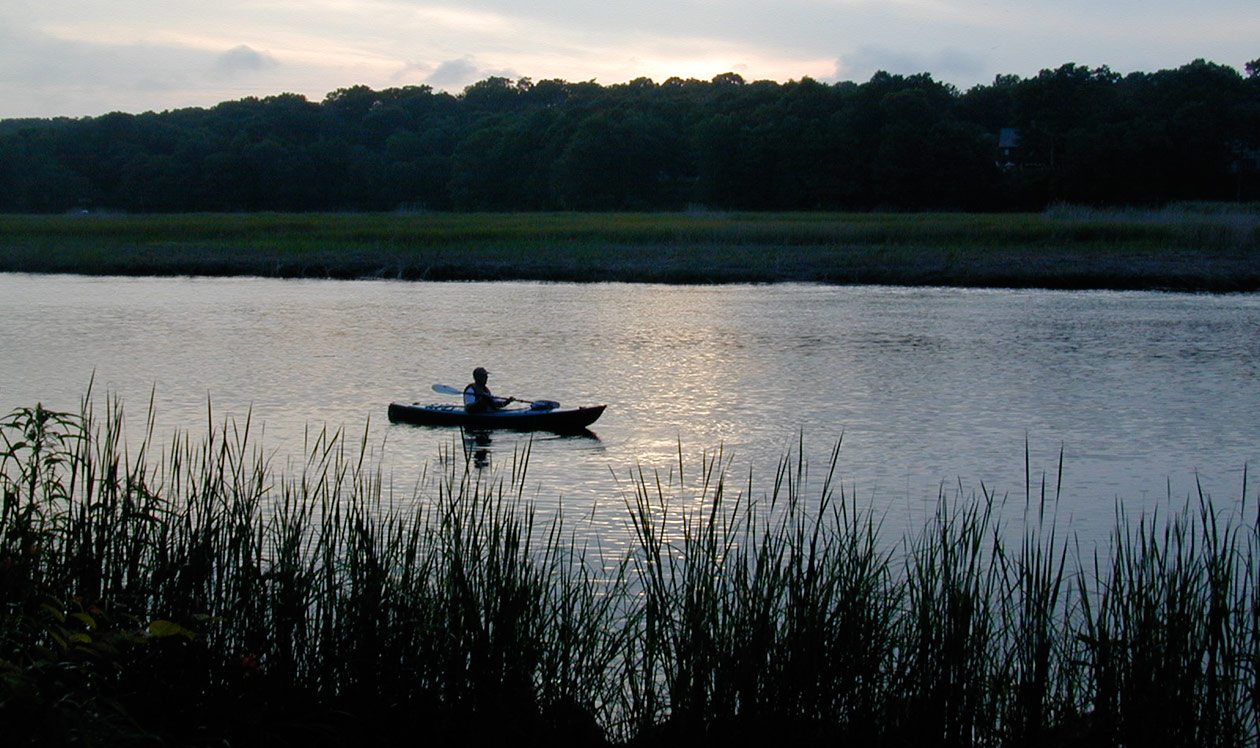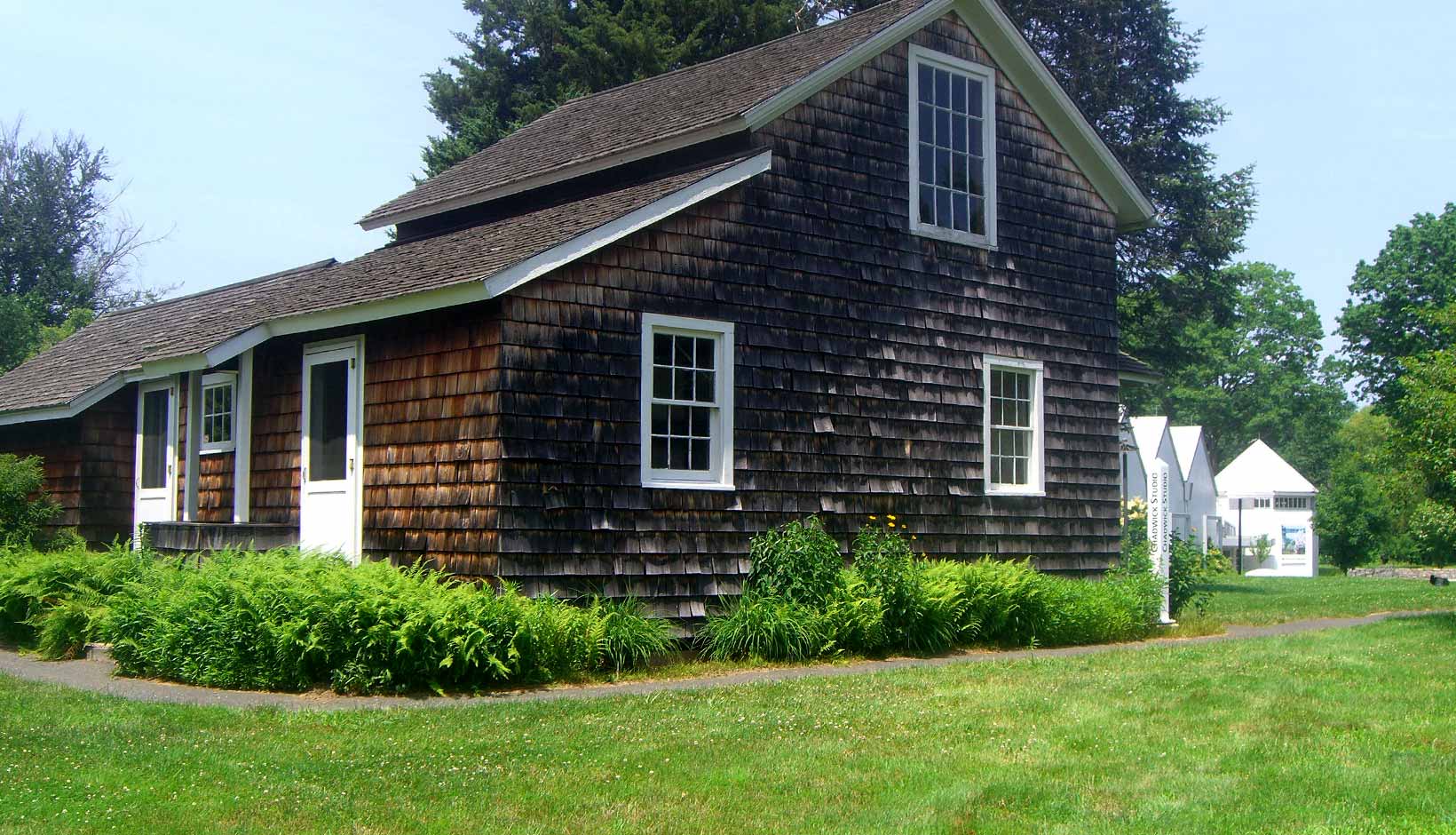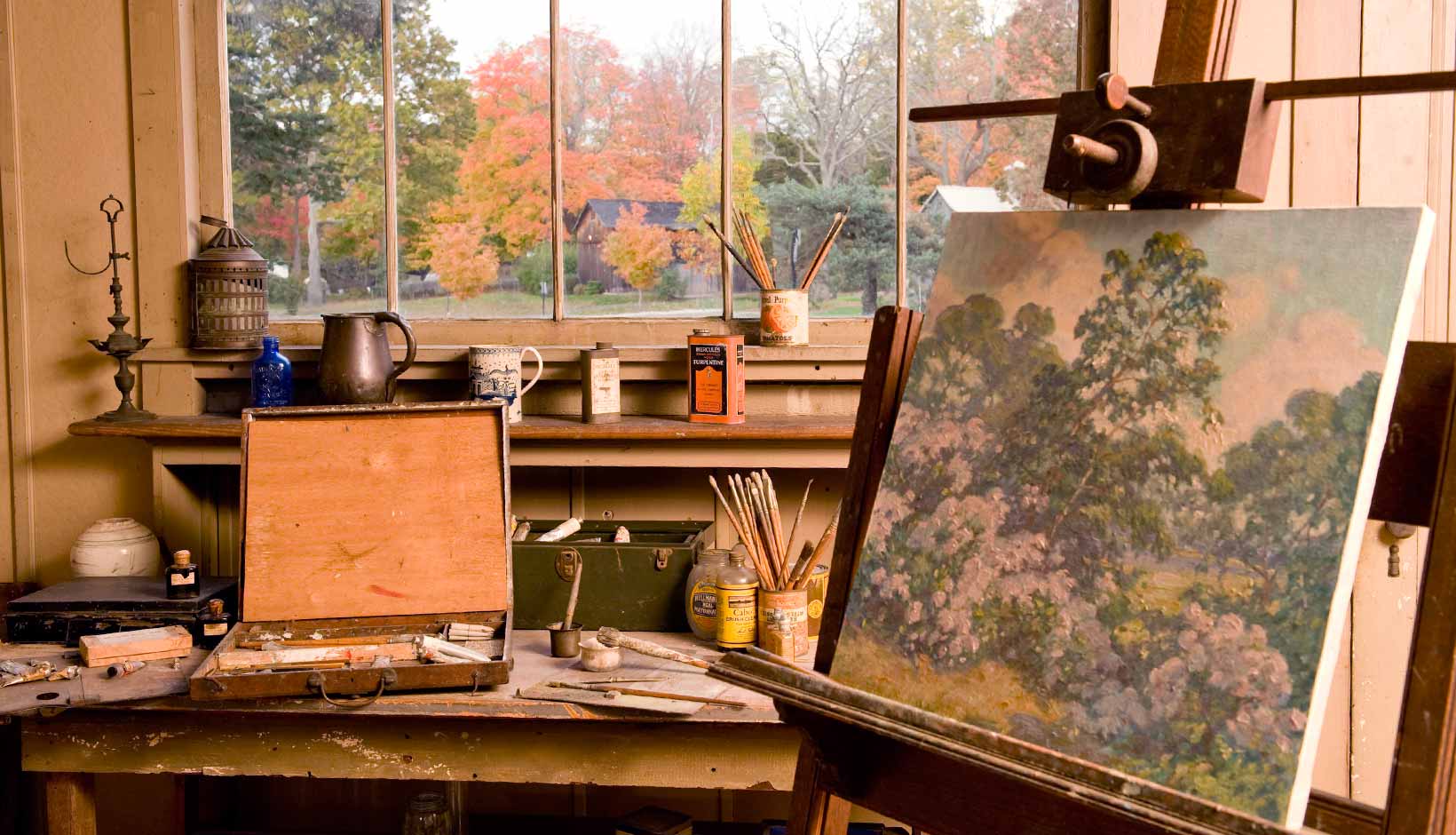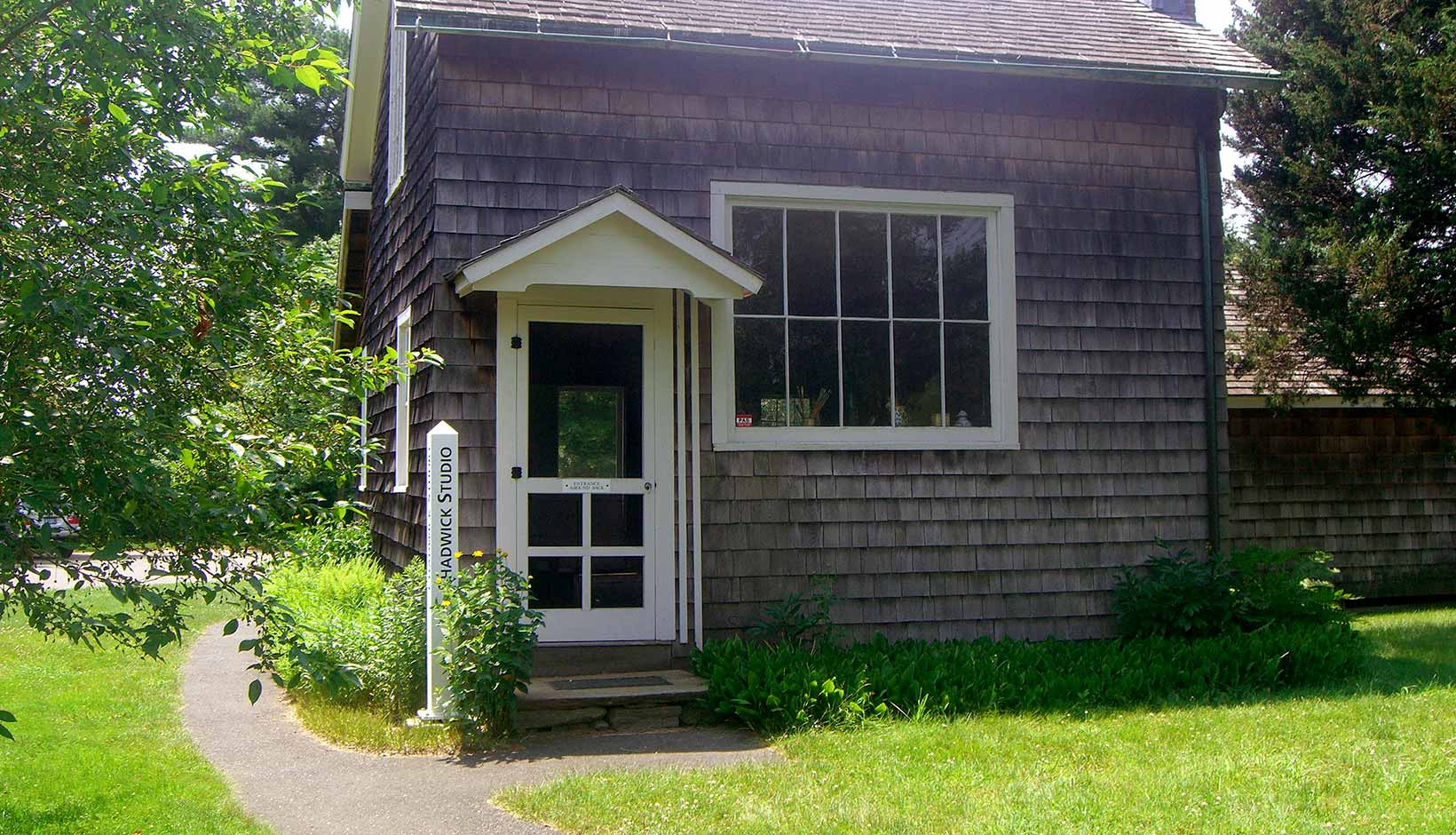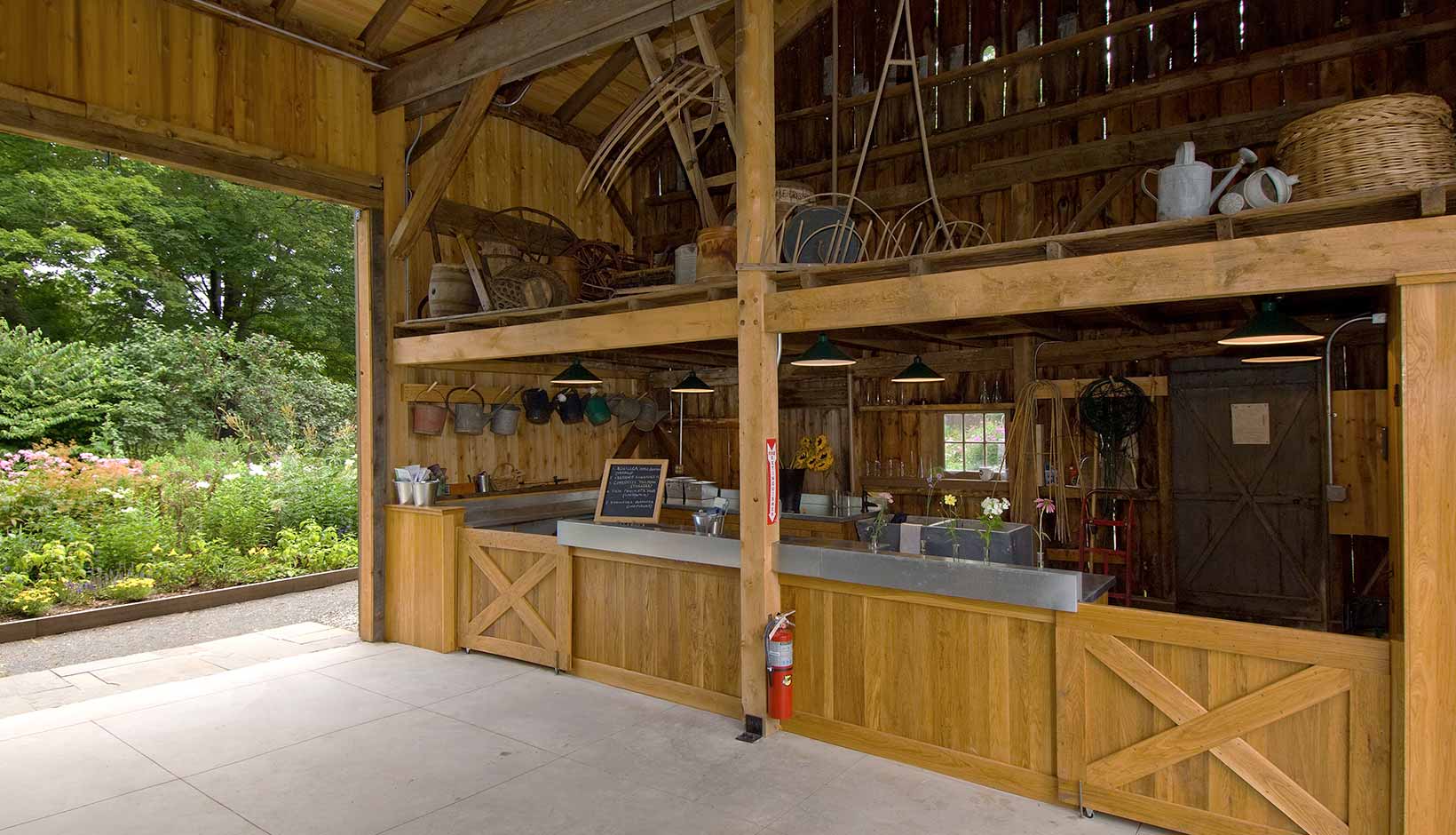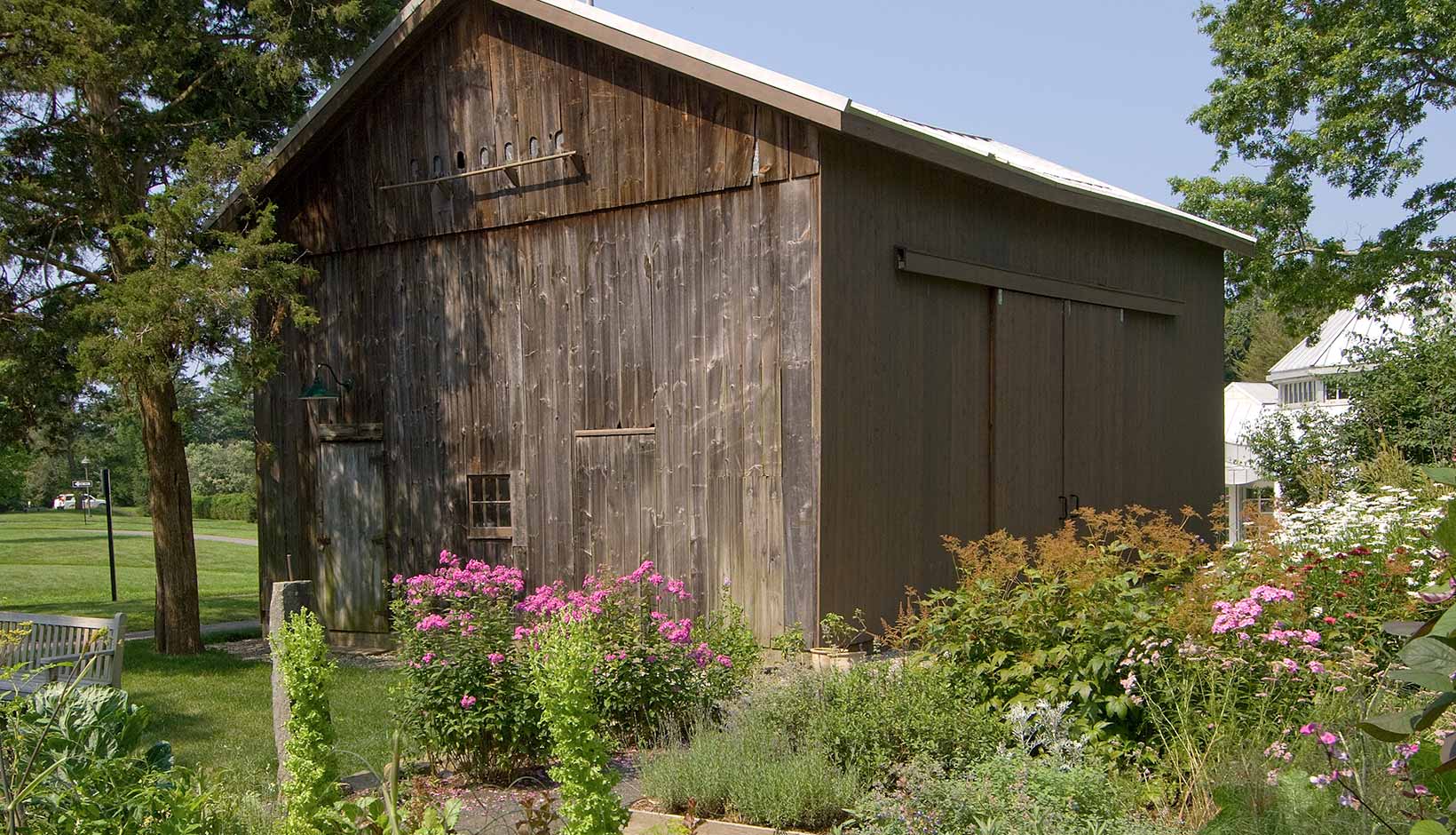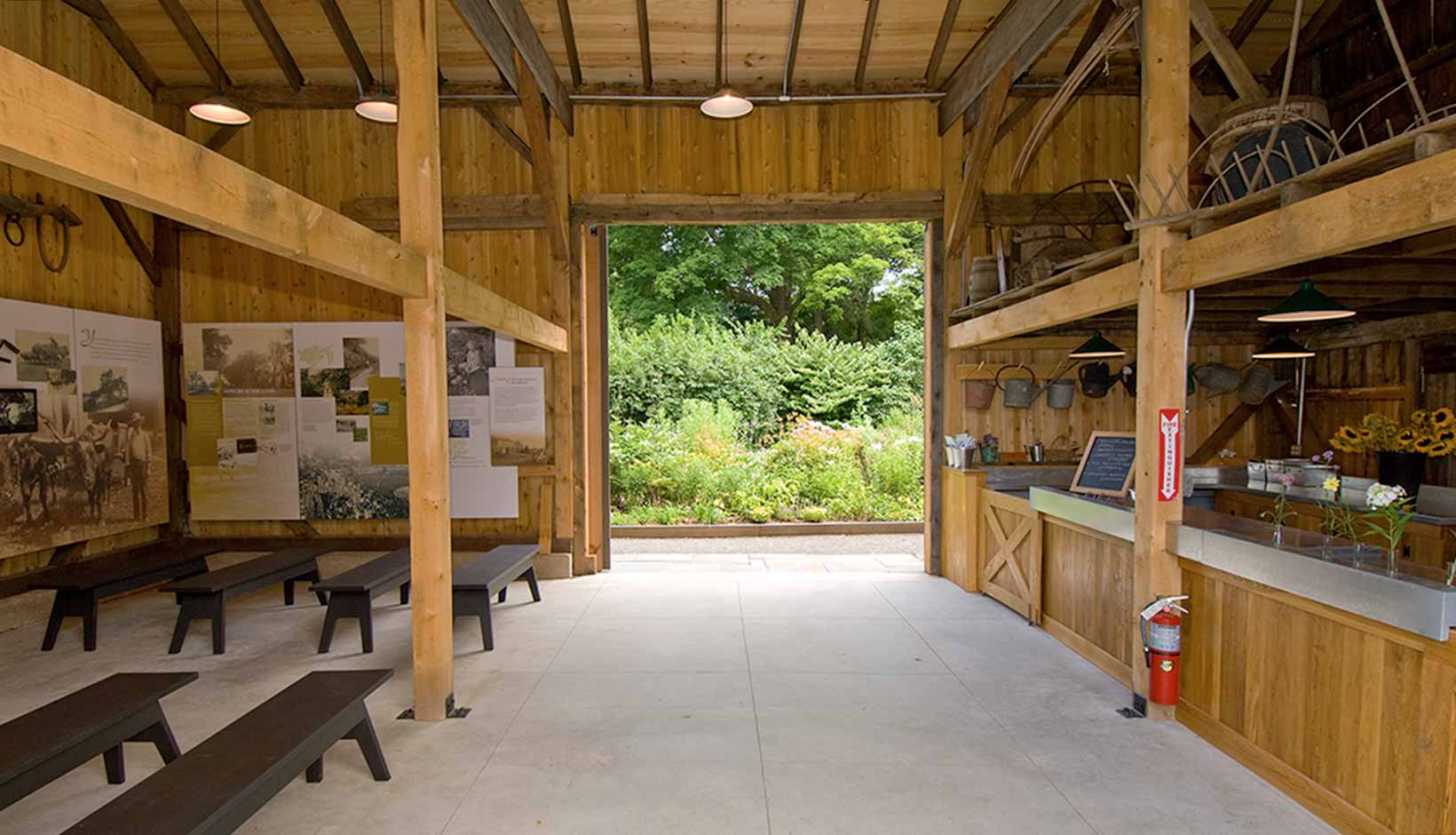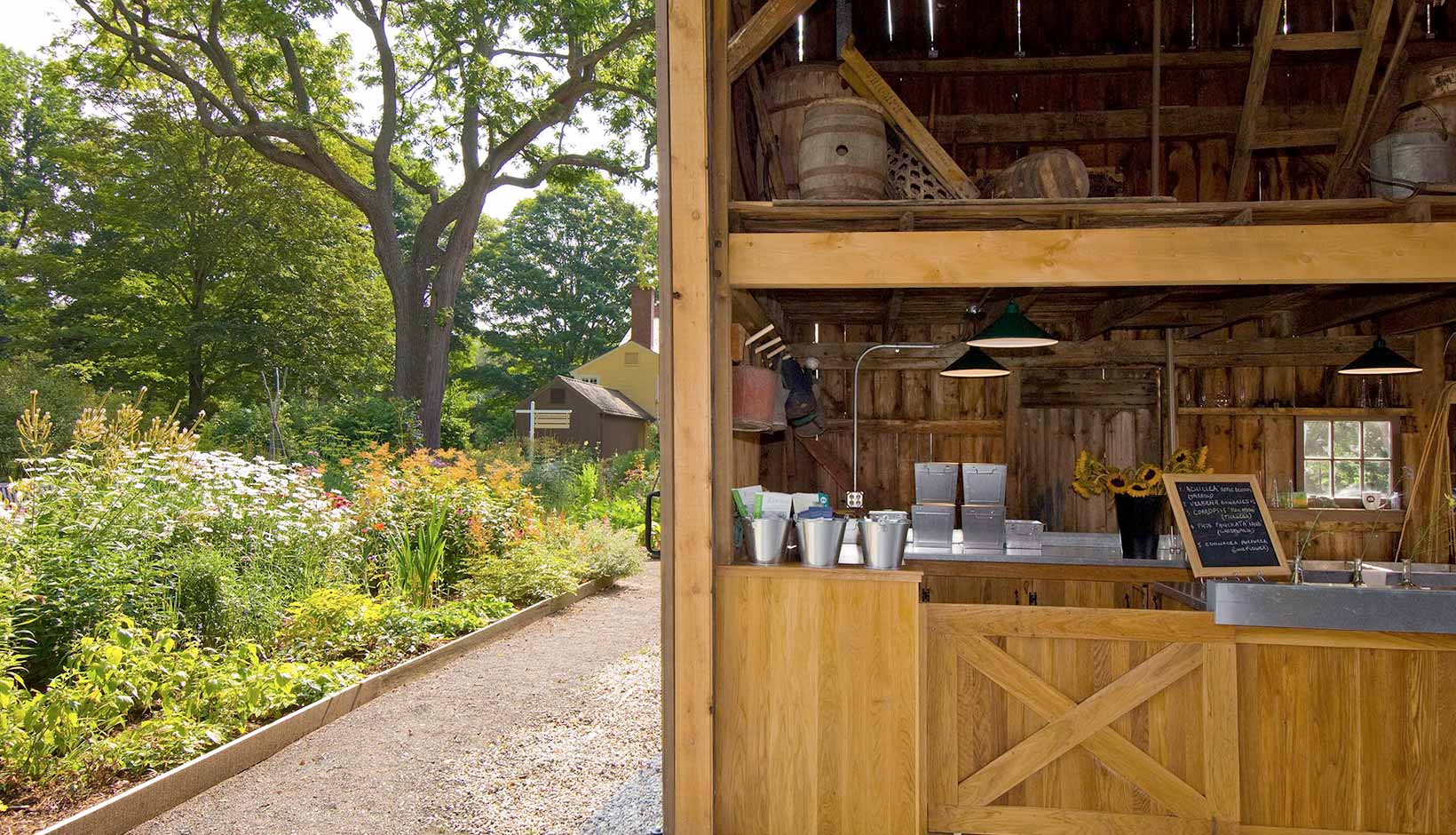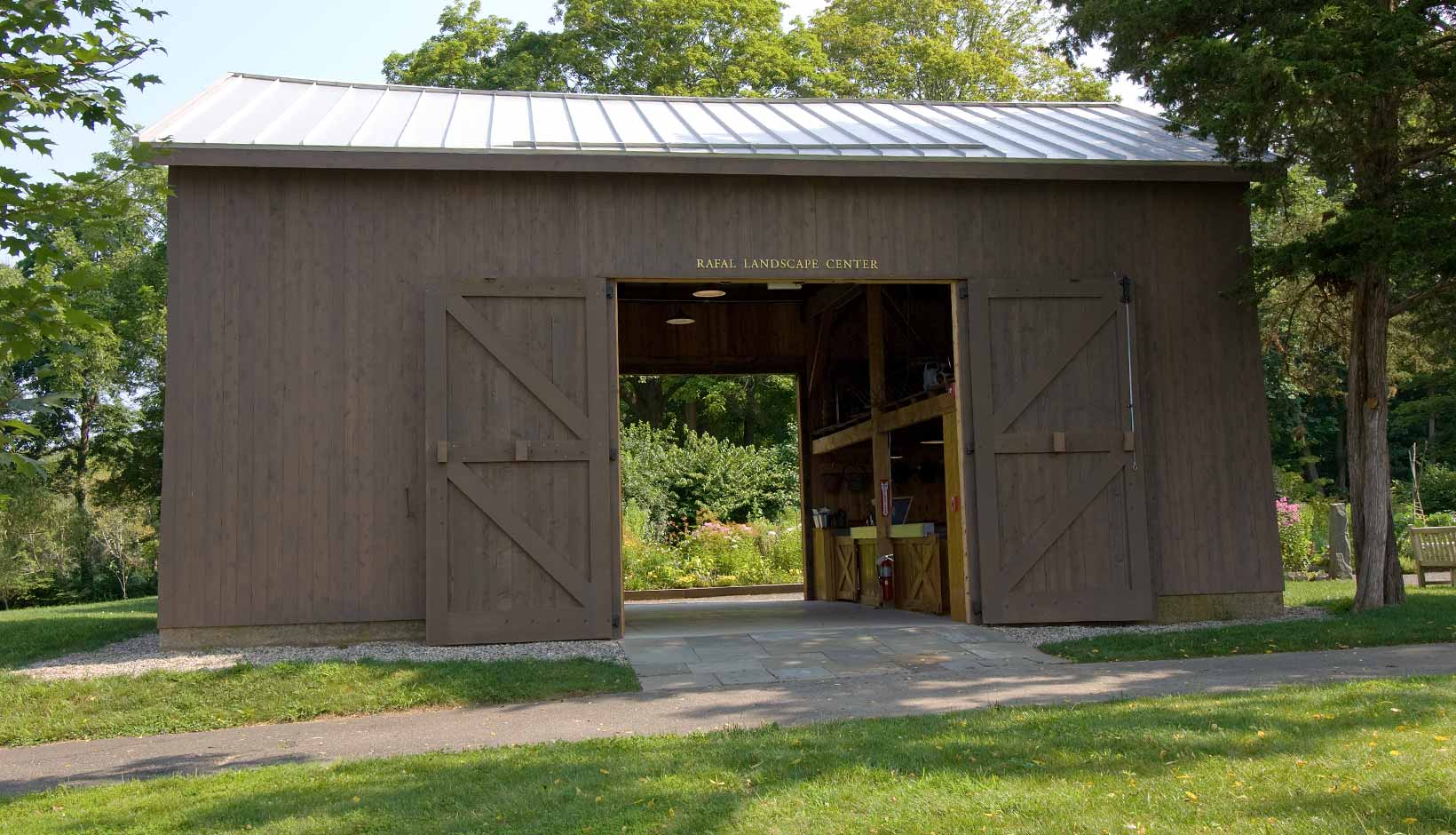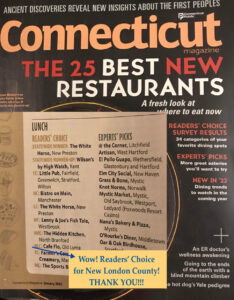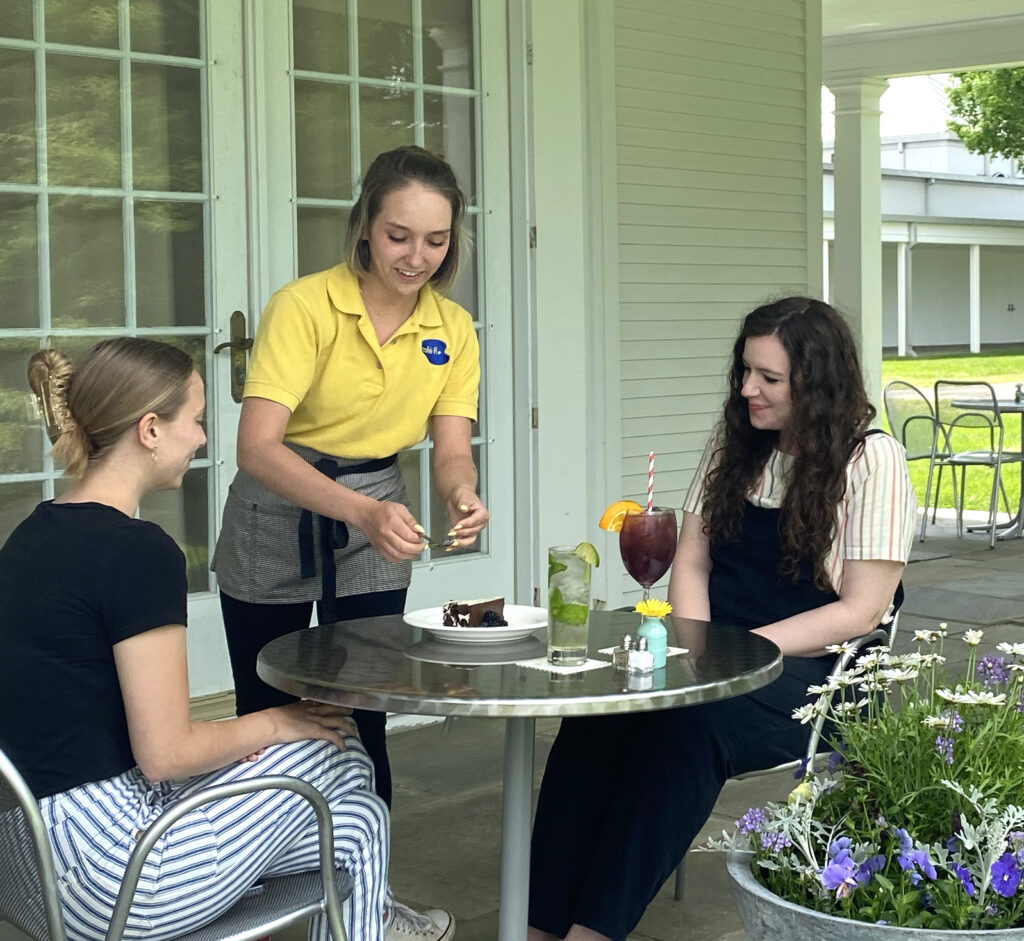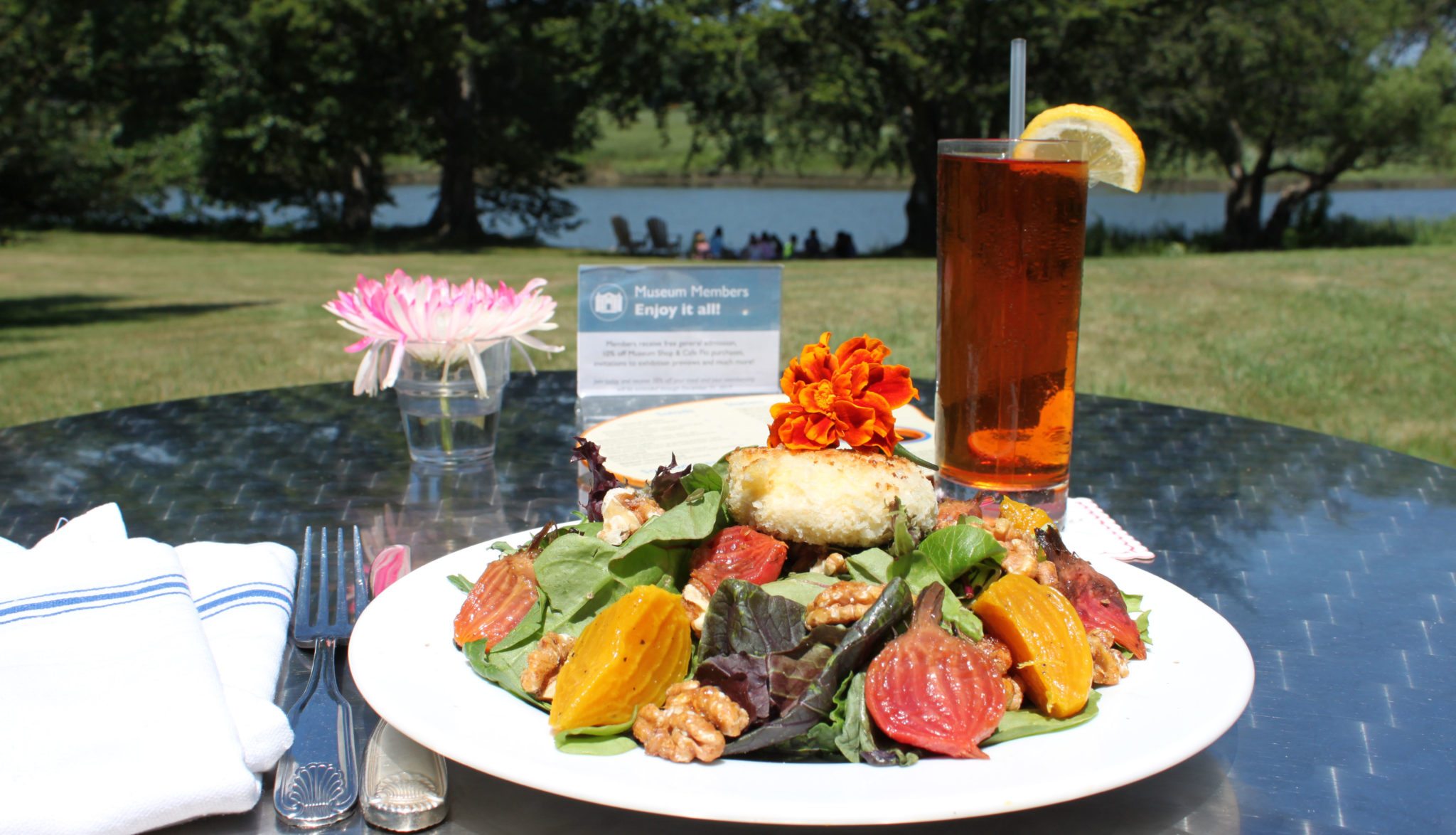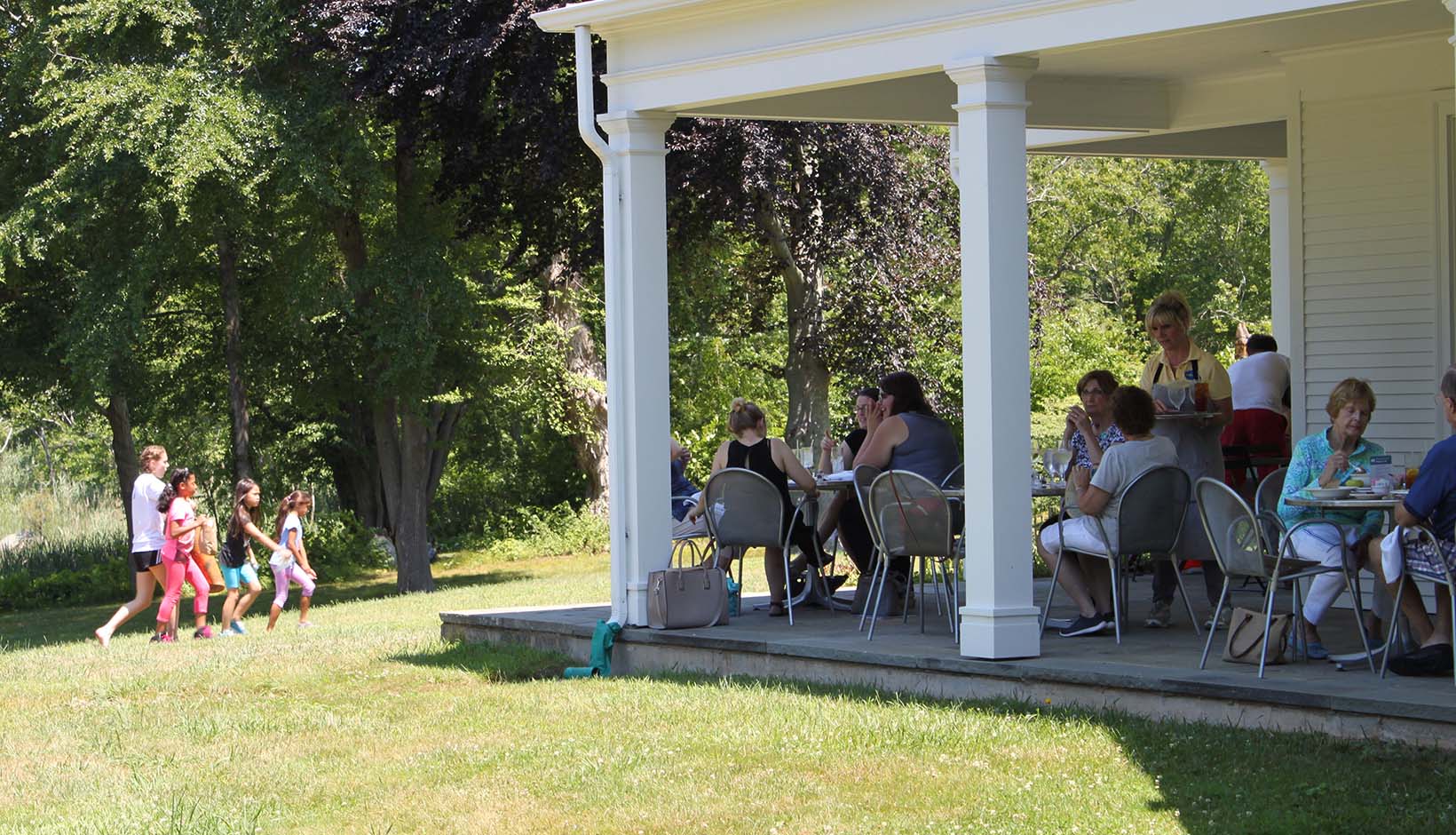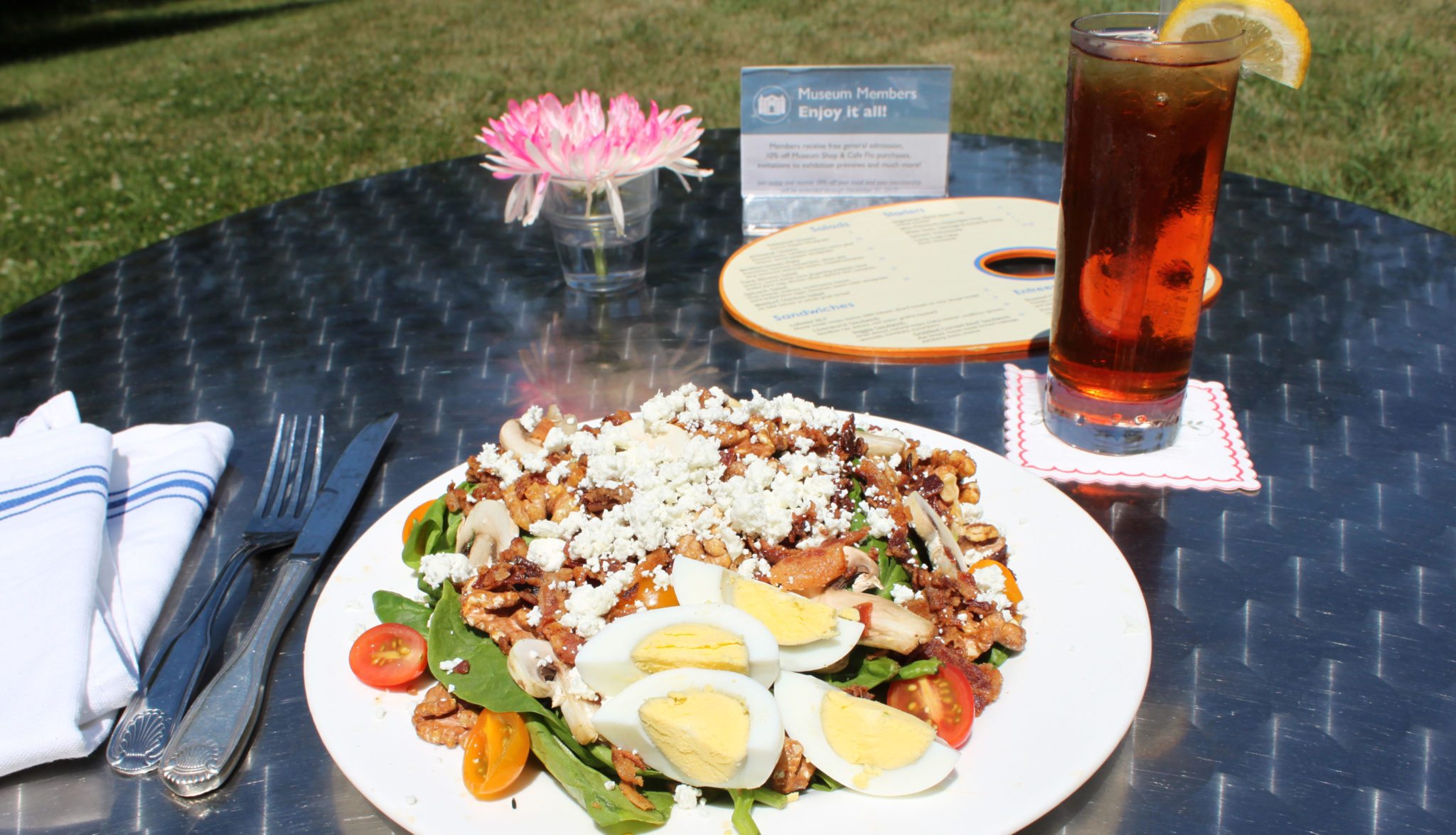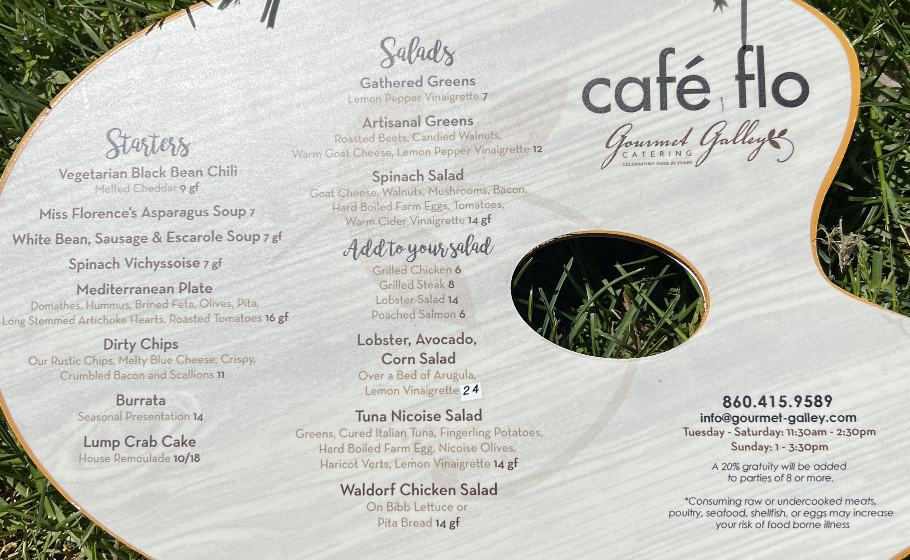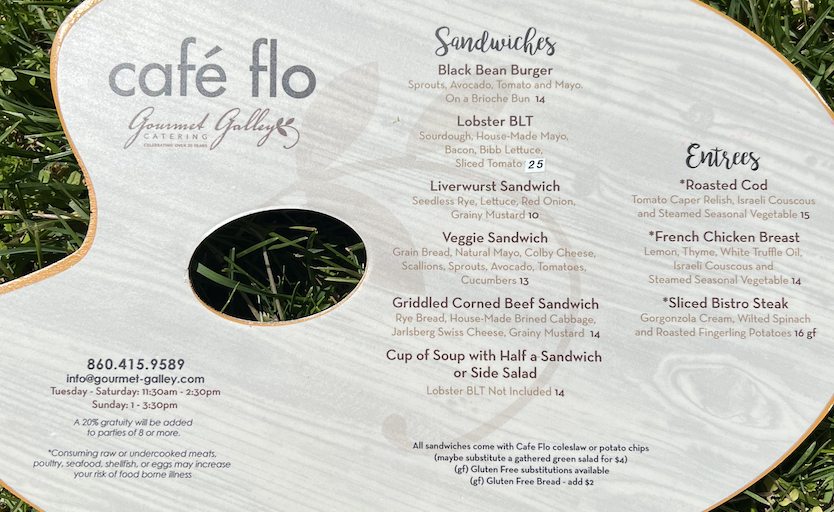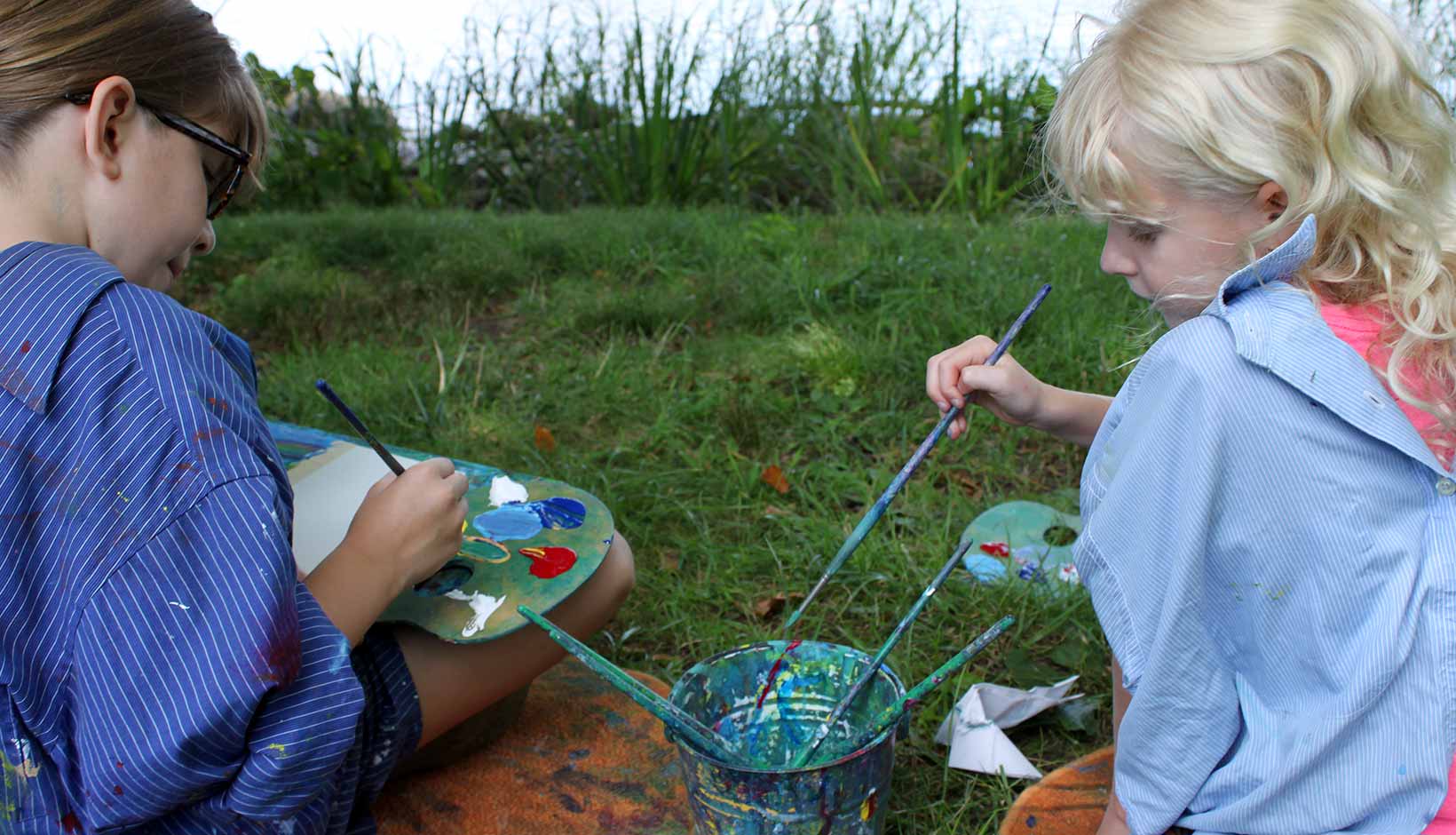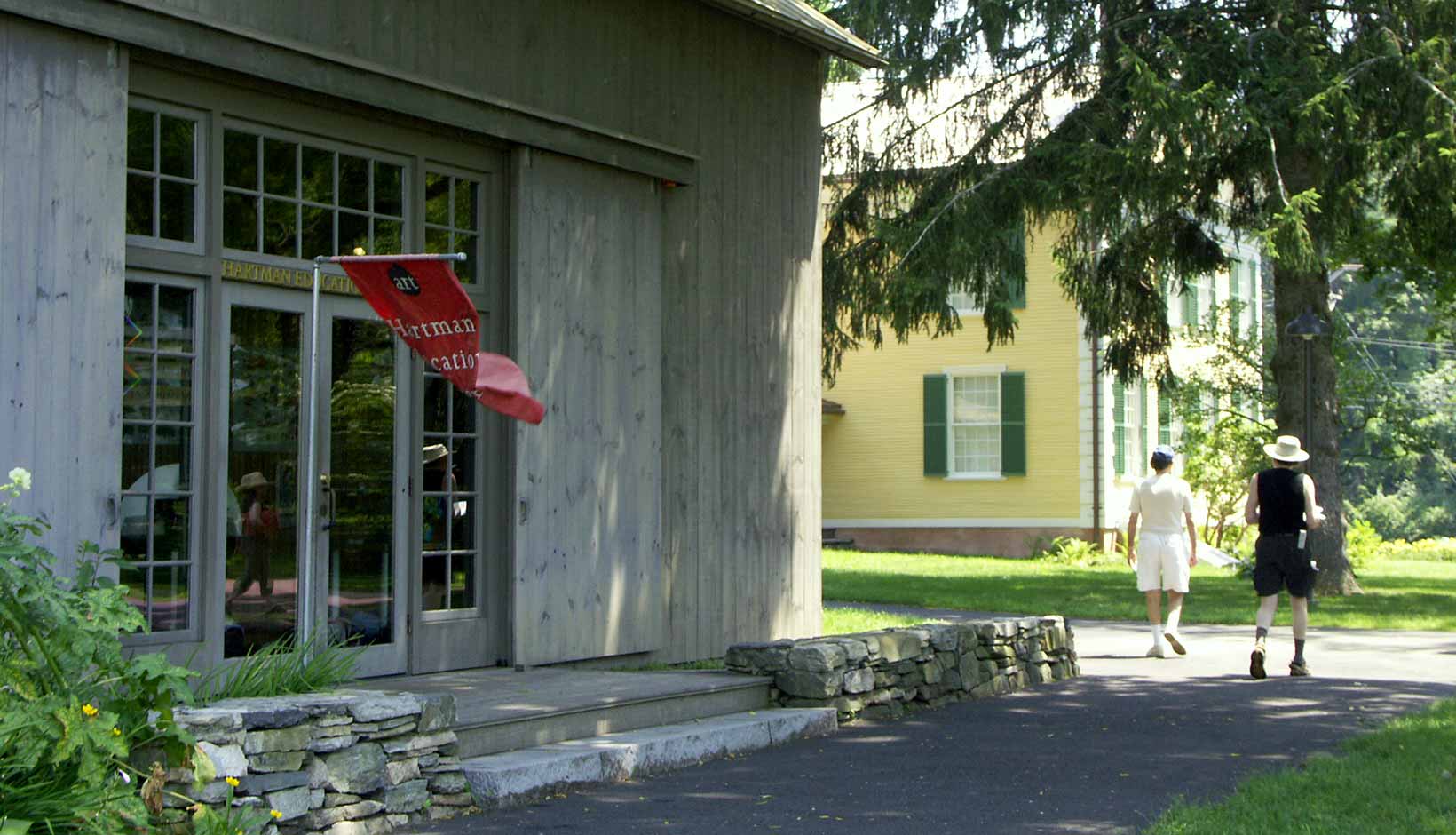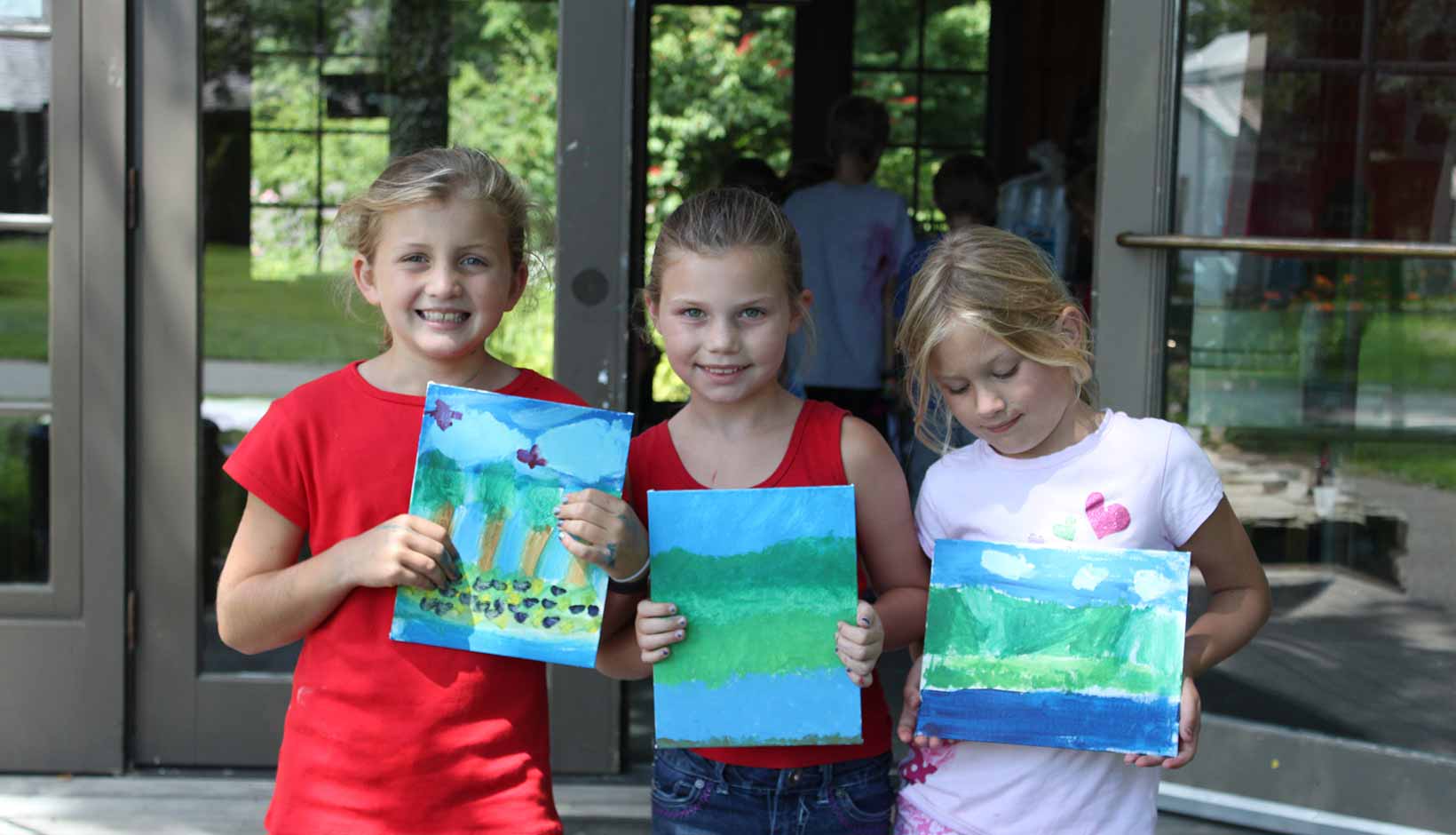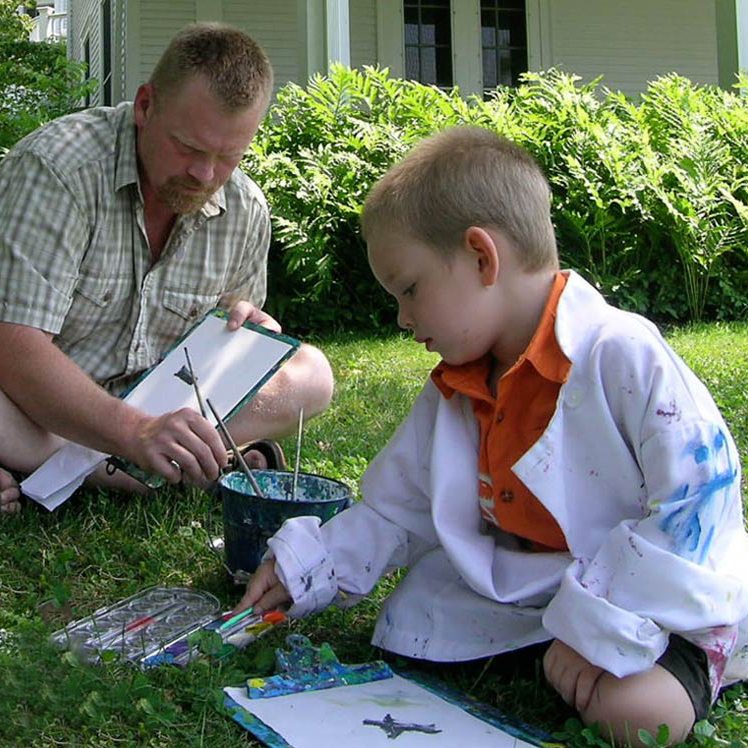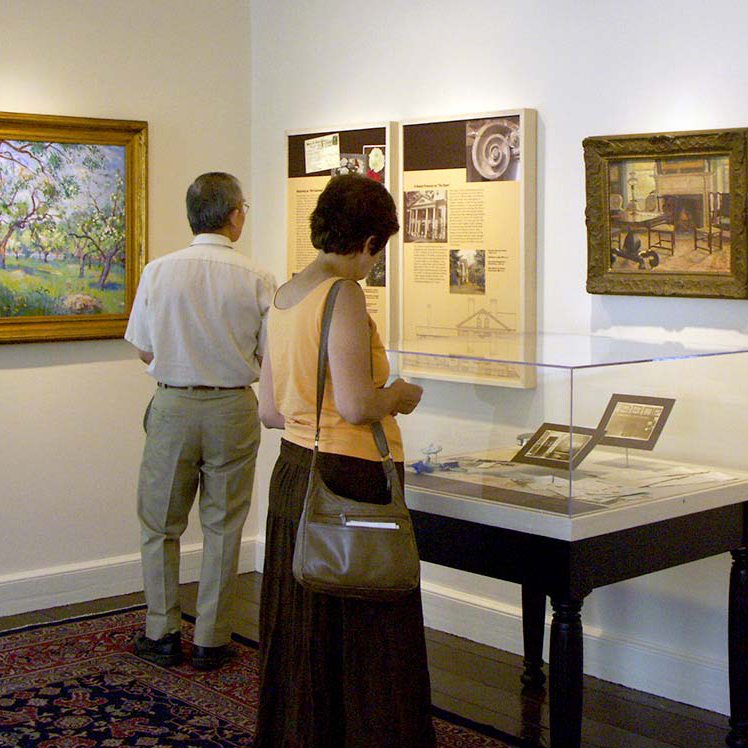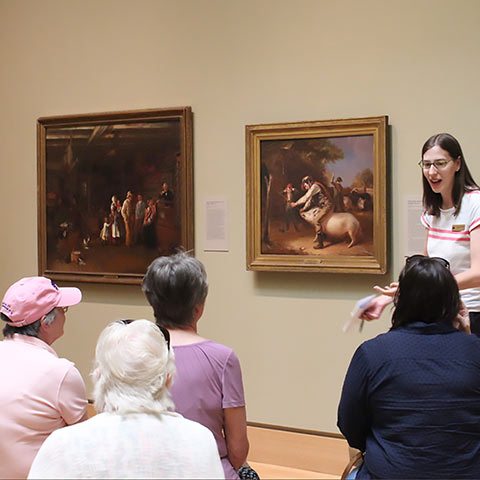Visit
Museum Campus
- The Museum will be closed Sunday, April 9 in observance of Easter.
Whether you come by yourself or with family and friends, you’ll make new memories with each visit to the Florence Griswold Museum.
Whether you come by yourself or with family and friends, you’ll make new memories with each visit to the Florence Griswold Museum. Discover American art from the 18th to the 20th centuries as well as changing exhibitions. Step back in time in the famed Florence Griswold House, the historic centerpiece of the Lyme Art Colony, where some of America’s most beloved artists lived and worked. Wander the gardens and riverfront that inspired a generation of artists. Enjoy a little shopping and perhaps lunch on the veranda to make the day complete.
Begin your visit at the Krieble Gallery.
Robert and Nancy Krieble Gallery
Beyond showcasing the current exhibitions, the Gallery houses The Shop, restrooms, the Visitor Lounge where an introductory video can be seen, and Café Flo. It leads to Marshfield, a Colonial Revival house where many of our lectures and events are held.
Exhibitions in the Krieble Gallery change three to four times each year. From collaborating with outstanding institutions such as the Fenimore Art Museum, the Portland Museum of Art, and the Parrish Art Museum to exhibitions such as The Exacting Eye of Walker Evans based on new research by our curators, there is always something on view to delight and inspire. Looking with little ones? Families can pick up Can You Find Me? Cards in the gallery area and search for details in the paintings featured in the exhibition.
The Florence Griswold Museum opened the Robert and Nancy Krieble Gallery in 2002. Designed by Centerbrook Architects, recipient of the 1998 AIA Firm of the Year Award, the gallery accommodates exhibition space, collection storage, visitor amenities and the museum shop. Overlooking the Lieutenant River, near where many of Miss Florence’s boarders set up their easels and painted the marshy coastline, this modern facility draws upon the Museum’s unique history and setting.
Visitors enter under a rippling aluminum canopy, which echoes the tidal river just beyond. Flowering vines scaling stainless steel arbors provide verdant contrast to the smooth white building and pay homage to Miss Florence’s lush gardens. Recognizing the importance of light to the Impressionist painters, the curvilinear connecting walls reflect sunlight, cast shadows, and create an airy, welcoming effect. Inside, specially designed skylights allow visitors to experience the artwork in an ambient natural light.
Krieble Gallery
A National Historic Landmark
Florence Griswold House
Designed by Samuel Belcher, architect of the First Congregational Church of Old Lyme, and built for William Noyes in 1817, the Late Georgian-style mansion reflects the affluent, formal style of living during Old Lyme’s maritime era.
Next, tour the Florence Griswold House. The Late Georgian mansion was transformed from a wealthy sea captain’s home into a boardinghouse for some of the most noted names in American Impressionism. Over 200 artists such as Childe Hassam, Willard Metcalf, and Matilda Browne found the lush countryside of Connecticut the perfect location for an American art colony.
The Lyme Art Colony artists left their marks not only on canvas but even on the doors and wall panels of “Miss Florence’s” house. Families can ask for a Scavenger Hunt with a list of objects to find in each room. The objects tell the story of the Museum so families can learn about the famous artists who lived in the house over one hundred years ago. Return the sheet to the front desk for a prize.
More than a remarkable building, the Florence Griswold House occupies a unique place in the history of American art. It brings alive the work of American Impressionist artists in the place where they lived and painted. The period rooms rekindle the spirit of another life and time.
At the Florence Griswold House
Gardens & Grounds
“A veritable tangle of fragrant beauty…” — Journalist Alice Lawton, American Motorists, 1928
The historic gardens at the Florence Griswold Museum were re-created with the help of an archaeological dig that took place on the grounds behind the House in 1998. During that time, the locations of the original flower and vegetable gardens, as well as the foundation area of one of the barns, were discovered. Landscape historian Sheila Wertheimer created the design of the garden based on these findings as well as referencing paintings and written notes about the home and landscape during the height of the Lyme Art Colony around 1910.
The flower gardens appear in many paintings by the Art Colony artists; since they stayed at the House for days at a time, they captured blooms at their best and in the perfect light. The porch at the back of the House was a favorite place for meals, particularly when the hot, humid days of the New England summer set in. From there, the artists had a picture postcard view of the gardens and fields that sloped gently down to the Lieutenant River. William Chadwick’s painting, On the Piazza captures one such occasion, and Matilda Browne and Childe Hassam spent many hours outdoors interpreting the landscape on their canvases.
Miss Florence was a passionate gardener — the beds were filled to overflowing with colorful, fragrant flowers, and she sold pansies, cut flower bouquets, and roses to help sustain the household. Her childhood home-turned-boarding house showcased bouquets on the tables and other furniture on the main level, the scents wafting throughout the rooms all season long to the delight of her guests. Miss Florence helped many of the artists design their own gardens at the new properties they purchased in Lyme and Old Lyme.
Victorian period gardens trended toward a less formal, more personal design, and the historic gardens on the grounds of the Florence Griswold Museum reflect these influences. Miss Florence loved following the ‘new’ ideas by garden designers of the times such as Gertrude Jekyll. She combined her favorite scented and colorful blooms into raised garden beds. Phlox, heliotrope, iris, and peonies appear in mixed borders in graduated levels, rather than mass plantings of singular varieties in blanket-like patterns. Tall oriental lilies, roses, violets and lavender were popular and their strong perfume lured the artists into the gardens to paint en plein air.
A Working Garden
As was the case with most homeowners at that time, this was a small farm that provided much of the food served to the boarders. Chickens and geese provided eggs, a cow or two gave milk and the cream that was made into butter (and maybe even homemade ice cream.) Strawberries and asparagus grew near the barns along with other vegetables. The orchard produced apples, cherries, and pears, which were made into pies and cobblers, while corn, beans, potatoes and pumpkins grew in the sunny spots nearer the river. Wheat was also planted, as many farms either ground their own grains or brought their harvest to small local mills scattered around the local area.
The historic gardens today are maintained by a devoted group of volunteers named the Garden Gang led by Gardens Coordinator Linda Turner. Many members have volunteered since the beginning, experiencing growth and changes of the site over the years. The Museum welcomes new volunteers to help weed, plant, and trim to keep the gardens at their best for Museum visitors. Educational programs about gardening and heirloom plants are being developed for both virtual and in person presentation to better integrate the gardens with the history of the House and the artists who painted them. We strive to honor the past while continually keeping informed about invasive and exotic plants (many were used as ornamentals through the period before gardeners realized their aggressive nature.) As time passes, the gardens will continue to replicate as closely as possible the varieties used by Miss Florence and offer the visitor a glimpse of typical designs of the period circa 1910.
Learn More
Interested in volunteering? Learn more here
To stay informed, sign up for our e-newsletter
or visit our YouTube channel for an informative video series In the Garden with Linda
The Museum is a proud member of Connecticut’s Historic Gardens
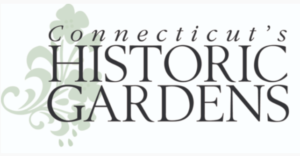
The Robert F. Schumann Artists' Trail
View 15 minute video of opening of the Artists’ Trail on July 22, 2019. Speakers Becky Beaulieu, Museum Director; David Schumann, son of Robert F. Schumann; and Bonnie Reemsnyder, First Selectwoman of Old Lyme.
Download new Visitor Guide here…
History of the Artists’ Trail
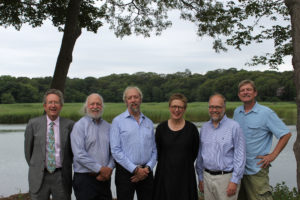 In 2017, the Museum was awarded a $1 million grant from the Robert F. Schumann Foundation for the implementation of a Landscape Master Plan designed by Stephen Stimson Landscape Architects. Robert Schumann was a devoted trustee and patron of the Museum for nearly two decades. The Museum seeks to honor Schumann’s legacy as an avid birder, conservationist, and philanthropist by dedicating the fully accessible Artists’ Trail, a major component of the project, in his honor.
In 2017, the Museum was awarded a $1 million grant from the Robert F. Schumann Foundation for the implementation of a Landscape Master Plan designed by Stephen Stimson Landscape Architects. Robert Schumann was a devoted trustee and patron of the Museum for nearly two decades. The Museum seeks to honor Schumann’s legacy as an avid birder, conservationist, and philanthropist by dedicating the fully accessible Artists’ Trail, a major component of the project, in his honor.
With a goal of providing visitors a more authentic sense of why artists were drawn to the site and how they interacted with the land, Stephen and Lauren Stimson and their team developed a Landscape Master Plan that re-envisions the entire 12-acre site by reclaiming its agrarian past featuring hedgerows, cart paths, riverfront meadows, and woodland thickets, which were lost over years of subdivision and development. After studying archival photographs, the Stimsons found that the Lyme Art Colony painters often worked within the estate’s edges, riverfront, brambles, and forgotten corners. This plan activates these edges to tell the artists’ story and provide ecological improvements, while directing a cohesive exploration of the grounds. Through the creation of a half-mile long Artists’ Trail around the edges of the Museum, visitors are immersed in a culturally interpretive exploration of the grounds, learning about the site’s history and its restored and enriched ecology at various interpretive stations.
The Artists’ Trail helps the Florence Griswold Museum provide visitors an experience that interweaves art, history, and nature in ways rarely found in the museum world.
More About the Gardens & Grounds
Chadwick Studio
Here visitors experience firsthand the working practices of American Impressionist artist William Chadwick (1879-1962).
From about 1920 until his death in 1962, this structure served as the artist’s studio. Chadwick created his studio from the conversion of vernacular outbuildings on his property, including an old cottage and an icehouse. The large airy room was the main studio and another room was used for storing paintings and supplies.
While Chadwick was strongly committed to the “en plein air” tradition of Impressionism, particularly in depicting the landscape, he used this studio for figure painting, still lifes, and finishing landscape paintings begun in the open air. Originally located in a field behind Chadwick’s home about three miles from the Museum, the studio was donated by the artist’s daughter-in-law and moved to its current site complete with its furnishings in 1992. The studio is furnished and appears today as it did during his lifetime.
Open the first Saturday in April through October during regular museum hours.
Rafal Landscape Center
The Rafal Landscape Center is located in a traditional 19th century barn. An exhibit featuring a silent film from the 1920s, reproductions of historic photographs and paintings, and a selection of agricultural artifacts illustrate how people have interacted with the Lyme landscape over time.
The Center features The Landscape of Lyme, an exhibition that highlights the history and significance of the region’s landscape. In addition, the building is the site for social and educational events throughout the year and may be rented for private parties.
This outbuilding, which dates to the mid-19th century, is worthy of preservation as an example of a surviving Connecticut barn and as part of the cultural landscape of the Lyme Art Colony. The barn underwent a comprehensive restoration in 2009 to make it structurally sound, ADA compliant, and accessible to the public. Every effort was made to maintain the barn’s rustic character.
The architectural plans and design decisions were guided by how the barn looked in the early 20th century as documented by paintings and photographs in Museum’s collection. The barn’s appearance is consistent with the presentation of the Florence Griswold House as a boardinghouse for artists, c. 1910, and the interpretation of Miss Florence’s perennial and vegetable gardens, which are adjacent to the barn. Funding for the project came from a variety of sources, including a generous gift from the Rafal Family and a Historic Restoration Fund grant from the Connecticut Commission on Culture and Tourism. The Landscape of Lyme exhibition was made possible thanks to a grant from the Connecticut Humanities Council.
Open the first Saturday in April through October during regular museum hours.
The Landscape of Lyme Exhibition
Old Lyme is buffered to the west by the Connecticut River and to the south by Long Island Sound. The area is noted for its topographical variety. Moving from the shore to the uplands, Old Lyme is a network of low lying tidal estuaries surrounded by salt meadows that rise to rolling farm fields and rocky upheavals topped by deep shadowed forests. The Landscape of Lyme, explains the evolution of the land, beginning with how the last ice age covered the region with a mile-thick glacier of ice that gouged and deepened the valleys as it advanced and left boulders, gravel, and sand as it melted. Interpretive panels, photographs, and maps recount the impact of the different inhabitants, from Native Americans to the Dutch and English settlers of the 17th century to the 20th century artists who painted its tidal rivers and rocky shores. The exhibit features a silent film from the 1920s and reproductions of historic photographs to convey the openness of the local landscape that once existed when artists from all over America visited the area. Reproductions of paintings, together with a selection of agricultural artifacts, give the visitor a sense of how people have interacted with the Lyme landscape over time.
Café Flo
Visitors can enjoy a lovely lunch at Café Flo, located on the veranda overlooking the Lieutenant River. Dine with table service on the veranda or picnic on the lawn. The Café’s delicious and inventive dishes are prepared by Gourmet Galley using only the freshest ingredients available from local farmers and purveyors.
We can now say “award winning”! Connecticut Magazine selected Café Flo for Best Outdoor Dining.
Thank you Connecticut Magazine readers
for making Café Flo your New London County
favorite lunch place (2022)!
Would you like information on weekly specials and other Café Flo offers? Follow them on Facebook!
Would you like to give a Café Flo gift certificate? Click here!
Café Flo reopens Tuesday, May 2!
Café Flo Hours
Tuesday – Sunday 11:30am to 2:30pm
Closed Mondays
Reservations recommended
860.434.5542 x126
Children’s menu: Chicken fingers or grilled cheese $8. Peanut butter and jelly sandwich $6. All served with potato chips.
Please check our Museum calendar for announced Café closure dates.
View Café Flo's Menu
Hartman Education Center
Thanks to a schedule of year-round programs and events for adults and kids, the Hartman Education Center is an exciting place! Check the Calendar for activities and times.
Imagine a studio where preschoolers can listen to recorded harp music while drawing a picture of Miss Florence. A classroom where teenagers gather after school to watch a video about Impressionism before trying their hand at painting en plein air. A gathering spot for a local author to read a rough draft of a new book. The list of possibilities goes on and on.
The Kelly Bill and John W. Hartman Education Center opened in the summer of 1999. Designed by architect Frederick Biebesheimer of Interdesign, the Education Center is built on the site – and in the spirit of an original barn / studio that once stood there. The interior of the center is a light-filled, hands-on discovery classroom / studio / performance space. The fully equipped 1,100 square foot space offers flexible areas for activities, literary and dramatic presentations, and for the display of works created in the studio. The center provides an inviting atmosphere for children, families, and adults to use their imaginations and hands to experience the world of art, history, literature, and nature.

